|
|
|
|
Sir Aurel Stein's Second Expedition
1906-1908
On Google Earth
To
open this map you have to download
GE onto your hard-disc
Stein's Large Map of Turkestan (2.2 Mby)
Collection of Stein's expedition maps as Google-Earth overlays (inaccurate but still very useful!)
Stein's Second Expedition
During 30 months of fieldwork, Stein travelled over 16,000 kilometres. In April 1906 he crossed the Indian border, and passed through Swat, Dir, Chitral and Mastuj [all today in Pakistan], collecting historical and ethnographical data. While descending on the glacier of the 4,700 metres high Darkot Pass, he tried to trace the path of a military expedition, described in the Tang Liudian (Encyclopaedia of administrative law of the six divisions of the Tang bureaucracy), that crossed the Pamir and the Hindukush and descended towards Gilgit under the leadership of Gao Xianzhi (d. 756) in 747. Stein obtained the permission of the Afghan king to cross Wakhan and the Afghan Pamir, before taking a rest in Kashgar.
He then travelled through Yarkand to Khotan, spending the summer months in the unmapped highlands of the Kunlun range. Following this he excavated unknown settlements around Khotan, before returning to Niya. From Niya he went through Charchan to Charklik, and finally visited the ruins of Loulan.
In January 1907 he began to excavate the ruins of Miran. In February he continued his journey towards the caves of Dunhuang. At the final reach of the Suloho, he discovered some parts of an ancient wall that he called limes (border defenses).
Over the course of two months he surveyed a length of about 220 kilometres, and found the so-called Yumenguan (Jade Gate). The wall was built in the Han period to prevent the Huns in the north from invading.
In May Stein set off for his next destination: the Caves of the Thousand Buddhas, where one of the most significant archives of manuscripts was discovered by Wang Yuanlu in 1900. In a sealed cave, thousands of manuscripts dating to between the 5th and 11th centuries, and silk paintings, mainly from the Tang period, were preserved in excellent condition. This discovery gave a new impetus to studies related to medieval China and Central Asia.
In June 1907 Stein travelled towards the oasis of Anxi. He later began his cartographic survey in Nanshan, followed by a second winter excavation season in the Tarim Basin.
Covering a distance of 1,400 kilometres from Anxi to Karashahr, he followed the military and trade routes in use since the Tang dynasty between China and the West. He surveyed important sites in Hami (Kumul) and Turfan
In December he began to investigate the Buddhist sanctuaries of Ming-oi, to the south-west of Karashahr. Having visited Kuchar, he crossed the Taklamakan from north to south, heading in the direction of where the Keriya River meets the desert.
In February 1908 he began new archaeological research in Karadong. He later set off for the source of the Yurungkash River.
While surveying in the Kunlun mountains, he suffered a frostbite in his feet and had to have the toes of his right foot amputated.
In Oct 1908 he had himself carried on a stretcher to Leh and returned from Ladak via Srinagar to London.
The popular description of the second expedition entitled “Ruins of
Desert Cathay” was published in 1912. The scholarly results of the
expedition were published in the five volumes of “Serindia”
(1921).
Text from stein.mtak.hu
Records of Stein's Second Expedition:
Contents
of Serindia Vol 1-5
Popular description of Stein's Second Expedition
Contents
of Ruins of Desert Cathay, Vol 1-2
For faster reading:
Comprehensive 1-vol Description of Stein's travels
"On
Ancient Central Asian Tracks"
Without compunction I have cut suitable sentences from the meticulously verbose texts of Stein's manuscripts and pasted them without quotes or ellipses into my text.
Across the Hindukush to Chinese Turkestan
Srinagar-Swat-Dir-Darkot-Wakhan-Kashgar
2650
km
April
–June 23, 1906
|
|
|
|
Stein had received the royal permission of the King of Afghanistan to cross the Wakhan valley into China. He took a more westernly route than in 1900 through Swat and Dir Valleys to the Baroghil Pass. On his way he explored the historical route of Chinese general Kao Hsien-chih who in 747 A.D. led his force over Darkot Pass for the successful invasion of Yasin and Gilgit. From the Upper Wakhan he proceeded via Tashkurgan and east of Mount Mustangh Ata to Kashgar
Kashgar
June
9-23, 1906
|
|
|
|
Kashgar, Six Years after
My arrival at Kashgar
meant a return to ground familiar already from prolonged visits in
1900-190I . There my old friend Mr. (now Sir) George Macartney,
K.C.I.E., then the political representative of the Indian Government
and now His Majesty's Consul-General for Chinese Turkestan, offered
me the kindest welcome. But neither this nor the need of some
physical rest after six weeks of constant and arduous travel would
have been a sufficient inducement for a fortnight's stay had not a
host of practical tasks, connected with the organization of my
caravan, the purchase of transport animals, Hassan Akhun to head my
camels, etc., kept me hard at work all that time. Sir George's kind
offices, supported by his great personal influence and to some extent
also by a recollection of my previous archaeological labours about
Khotan, were a great help in securing the goodwill of the provincial
Chinese government for my fresh explorations.
It was a service of quite as great importance, when he recommended to me a qualified Chinese secretary in the person of Mr. Yin Ma Chiang or Chiang Szû-yeh, to give him his familiar title. For the tasks before me the help of a Chinese literatus had appeared from the first indispensable. I have never had a chance of extending my philological equipment by a serious study of Chinese. A kindly Fate gave me in Chiang Szû-yeh not merely an excellent teacher and secretary but a devoted helpmate. Full of true historical sense he took to archaeological work with keen zest and intuitive aptitude, and whether the remains to be explored were Chinese or foreign in origin, he watched and recorded everything with the same unfailing care and thoroughness. Apart from the great personal benefits which I derived throughout my explorations from the companionship of this learned Chinese comrade, science owes Chiang Szû-yeh direct debts for valuable scholarly labour in connexion with numerous tasks I shall have occasion to mention hereafter.
Early in the afternoon on June 23rd, I took leave of my kind hosts and the friendly shelter of Chini-bagh to start for Yarkand, my first étape on the long journey south-eastwards. It was not without a feeling of regret that I cast a farewell look over the sun-lit terraces of the garden and the stately poplar avenues which give shade to its walks.
The Macartneys by their hospitality and unceasing care had made my
stay a time of real rest in spite of all hurried labours. On saying
good-bye to them I felt as if I were parting with the last living
link, too, which bound me to dear friends left behind years before in
distant Europe.
Ruins
of Desert Cathay
Yarkand and Karghalik
June
26-July 7, 1906
After the trying heat of that afternoon and evening spent on the first march between Kashgar and Yapchan I realized that my travelling would have to be done mainly at night, both for the men's sake and for that of the animals. To take shelter during the day in a small tent such as mine was out of the question. So I had to abandon the thought of camping in the gardens which had offered peaceful retreats on former journeys, and instead to look out for a more solid roof to rest under during the heat of the day.
There were the official Chinese rest-houses or 'Kung-kuans' to receive me, spacious enough to accommodate us all. But their state of cleanliness left much to be desired. I preferred to seek refuge in the houses of well-to-do villagers. Again I was struck by the degree of comfort to be found there, far higher than anything in corresponding conditions in India.
It was just the season to make me realize fully the advantages of the Aiwan, that prominent pavilion in well-to-do people's houses throughout the southern oases. It is a kind of square central hall or Atrium, having a roof well raised over the central area and provided with clerestory openings on all four sides. Sometimes on one or two sides the upper wall portion shows merely a grated wooden framework, freely admitting light and air. Thus during the hot summer months the Aiwan gives not only cool shade but access for any fresh breeze. Rooms or
passages opening from this Atrium communicate with the rest of the house. One or two rooms, close to the entrance from the outer court, form the usual guest quarters known as ' Mihman-khanas.' Gay cotton prints hung as dados round the walls and Khotan carpets spread on the floors make them look quite cosy. But as light and air are admitted only by a small opening in the mud roof, the Aiwan itself makes far more inviting summer quarters. Raised platforms extend along all its walls, broad enough for rest or for work, and, as the position can be varied, what sunshine and heat passes in may be dodged.
The refreshing cool air of my quarters made it easy to use my four days' stay at Yarkand to the full. Additional ponies were secured after a good deal of trial and bargaining, among them a good-looking young bay horse for my own use, which passed as of Badakhshi blood. It proved with experience as hardy a mount as I could wish for, indefatigable on the roughest ground and quite inured to the privations of deserts without grazing. So, in spite of its unsociable temper 'Badakhshi' in time became dear to my heart as a constant companion.
Two long marches on July 5th and 6th brought me to Karghalik. The
barren yellow sands of the desert edge remained ever in view as we
moved south
Ruins
of Desert Cathay
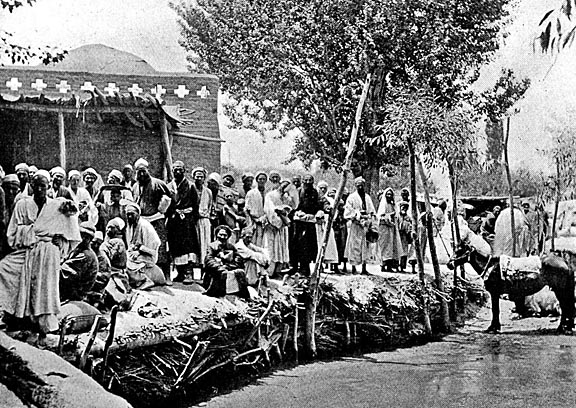
Curious
bazaarliks watching Stein's caravan in Karghalik
Along the Foothills of the Kunlun
to Khotan
July 7
- Aug 5, 1906
Excursions into the cool Kulun Mountains
The
desert had become too hot (105 F) even at night. Stein decided to go
on a detour of the Kunlun range. At its elevations above 3000 m it
would be cooler. He sent his Indian surveyors ahead and followed with
a much reduced caravan.
After an intial exploration searching for a passable entry south of Khargalik he made his way to Khotan, Finding Khotan still unbearabely hot he set out a second time towards Nissa (mid July). Both routes appear entangled on the low resolution facsimile map.
The problem with Steins geographical surveys is - he would spend the next summer in the Nanhshan and the summer of 1908 on a third exploration of the uncharted Kunlun - that his local names are not traceable on modern maps, neither do his maps agree with the satellite maps of today. My alignement of these routes is, therefore, only tentative and highly approximate.

The
Kunlun Range from the Desert south of Karghalik
In the early dawn of July 7th I started from Karghalik southwards. There was just light enough as we rode through the Bazars to observe the gaily decorated cook-shops and a stately Mosque and Madrasah with polychrome woodwork. Karghalik once again reminded me of some small town in Kashmir, probably on account of its fine trees, the abundance of running water, and the plentiful use of timber in its houses
Slowly our animals dragged themselves over the curious stretch of red loess which extends for over a mile beyond. When the rising dunes told me that we were getting near to ` My Lord of the Sands' Shrine,' which was to give us shelter for the night's halt, animals and men worn out by a march of some thirty-six miles over such ground. I recognized the high poles and modest huts of the `Pigeons' Shrine ' amidst patches of reeds and tamarisk, growing between the dunes.
The sacred birds which now receive the wayfarers' worship, instead of the sacred rats of Buddhist days, had retired to rest when we reached the spot by nightfall. So there was nothing to disturb the delicious peace of the desert. It took nearly two hours more before the last of the baggage ponies had come in.
When I rose next morning at 4 A.M., later than usual in those days,
the air was still fresh, the thermometer showing 6o° Fahr. While the
baggage was getting ready I made my food offering to the sacred
pigeons, a duty which my old followers would on no account have
allowed me to neglect, to secure the holy birds' goodwill for the
long journey before us.
Desert
Cathay
Khotan
Aug 5 -
Sep 15, 1906
A month later, on August 5 Stein was approaching Khotan from the south. Here follows his unusually emotional account of his “home-coming” to Khotan, well remembered from his first expedition.

T'ang
Ta-Jên, the Military Amban of Khotan, with his Sons and Attendants
A Nostalgic Home-coming.
The day which brought
me back to ' the Kingdom of Khotan ' will long live in my memory as
one of the happiest of my many journeys. It is always delightful to
revisit scenes to which one's thoughts have longingly returned for
years past, and still more delightful to find that the memory of
one's self still lives among those scenes.
I was met by quite a cavalcade of Begs sent from the Amban's Ya-mên. At Zawa I found the neat little official rest-house by the road-side gaily decked with red cloth, and refreshing tea and fruit ready on the raised central platform of the courtyard. Fresh evidence, too, of the Amban's attention came in the form of pony-loads of fodder for my animals and provisions for myself, offered as a special sign of regard at my entrance into the district. The Kara-kash River, now swollen by the melting snows, could not be crossed on the high road that leads straight to Khotan town. Boats were to be found only at Kara-kash town, some ten miles farther down.
As I approached Kara-kash, my escort was joined by the local Beg, a person of consequence, looking grand in his blue silk coat and official Chinese cap with crystal button and horse-tail. As etiquette makes all such dignitaries insist on riding in front of one, in due order of rank, there was plenty of dust to be swallowed in return for such exalted attention.
A march of some sixteen miles on August 5th brought me back once more to the Khotan capital. It was a day of trying heat, but full of most cheering impressions. The crossing of the Kara-kash river, now in full flood, took us a long time ; for though there were two fairly big ferry-boats available for our party and baggage, the rapidity of the current and the sand-banks, sorely tried the modest skill of the 'Suchis' or watermen.
At the reception-hall built by the road-side I found a pompous gathering of Chinese officers in flowing silk robes, and an array of picturesque figures with swords and halberds representing a selection from the garrison. The military Amban, T'ang Ta-Jên, who, a descendant of the imperial Chinese line, did the honours and received me with a great show of friendly animation,
Badruddin Khan, the head of the Afghan traders' community, had
prepared quarters for me at Niaz Hakim Beg's old garden palace,
Nar-bagh, where in 1901 my last stay in Khotan had been spent. It was
only when I passed through its shady Aiwans and halls into the
familiar garden with its central pavilion, where I again established
myself, that I felt fully assured my longed-for return was a
reality.
Desert
Cathay
Keriya
Oct 7- 17,
1906
Buying Camels
Keriya was the last place where
I could make sure of replacing the camels which, by a succession of
deaths due to some unexplained illness, I had lost since August. We
had taken all possible care of the fine-looking animals acquired at
Kashgar, and used every chance for giving them rest and plentiful
grazing.
For two days I was treated to the wearisome inspection of long strings of camels either too young or past work, while it was evident that more serviceable animals were being carefully kept out of sight. Repeated complaints in the Ya-mên prevailed in the end, and by the fifth day seven big and strong animals had been picked out in spite of all dilatory tactics. - To judge camels' points requires the experience of a lifetime, or rather the inherited knowledge of a born camel-man. So it was no small comfort to feel that in a matter of this sort I could rely on Hassan Akhun's honesty quite as much as on the effect produced among the wily owners by his sharp tongue.
My brave camels from Keriya never caused me worry. They held out
splendidly against all privations and hardships, and after nearly two
years' travel were so fit and fine-looking that, when at last I had
to dispose of them before my return to India, they realized over
seventy per cent profit, of course, for the Government of
India.
Desert
Cathay
Niya and its Ruins
Oct
16 -28, 1906
New Finds in Niya
Niya had, in 1901, been Stein's great discovery, there he had found the first large cachet of Karoshthi tablets. In the interim the treasure hunters of Keriya, instead of searching for gold, had realized that the crazy foreigner would pay well for otherwise worthless written documents. -

Ibrahim,
the Treasure Hunter of Niya
From Ibrahim, " the miller," my old guide, who had first come upon inscribed tablets there, I learned that he had had traced a large group of `old houses' hidden away among sand-hills some miles beyond the western edge of the area previously surveyed. Guided by this information, I decided to take with me as large a band of labourers as my available iron tanks and goat-skins would allow me to keep supplied with water, and to push on excavations rapidly.
On the morning of October 20th we left behind the last abode of the living, and also the present end of the Niya River. Five camels carried the first supply of water for my column, counting in all over fifty labourers.
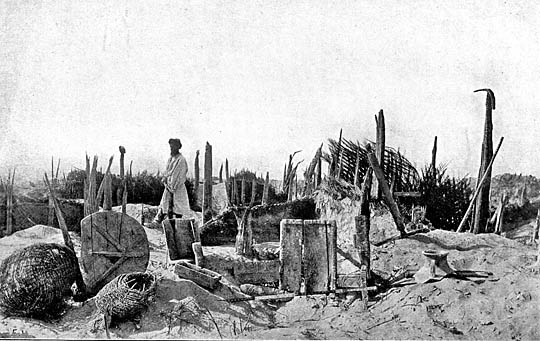
Partly
excavated house on the new northern site
Marching on over absolutely bare dunes for another two miles, I passed one after another of the ancient houses Ibrahim had reported. They lay in a line along what must have been the extreme north-western extension of a canal once fed by the Niya River. The line proved to be situated only about two miles to the west and north-west of the northernmost ruin we had been able to trace in 1901. But the swelling ridges of sand intervening had then kept them from view.
...Stein's excitement is rising....
I lost no time in commencing my day's work at the farthest ruined structure we could trace. It was a comparatively small dwelling covered only by three to four feet of sand. I had the satisfaction of seeing in each of the three living-rooms of the house specimen after specimen of this ancient record in Indian language and script emerge from where the last dweller, probably a petty official, about the middle of the third century A.D., had left behind this `waste paper.'
The men soon learned to scrape the sand near the floor in the approved fashion and, content with announcing their finds, to leave the careful removal of them to me. I could not help feeling emotion, when I convinced myself on cleaning them from the fine sand adhering, that a number of the rectangular and wedge-shaped letter tablets still retained intact their original string fastenings, and a few even their seal impressions in clay. How delighted I was to discover on them representations of Eros and a figure probably meant for Hermes, left by the impact of classical intaglios ! To be greeted once more at these desolate ruins in the desert by tangible links with the art of Greece and Rome seemed to efface all distance in time and space.
Equally familiar to me were the household implements which this ruin yielded. Remains of a wooden chair decorated with elaborate carvings in Graeco-Buddhist style, weaving instruments, a boot-last, a large eating tray, a mouse-trap, etc., were all objects I could recognize at the first glance,

Niya,
house with sculpted lintel after excavation, 1906
Discovery of the
Hidden Archive of
Honourable Cojhbo Sojaka
October
24th, 1906
For my new camp I had chosen the group of ruins on the extreme west edge of the site which on my previous visit had been discovered too late for systematic exploration. From a small and almost completely eroded structure to the south of the group nearly three dozen official letters on wood were recovered during the early morning of October 24th, 1906.
Here a rich haul awaited me such as I had scarcely ventured to hope for. Already when clearing the rooms north of the large central hall I had come upon some fine pieces of wood-carving (Fig. 92), including an 1 architrave in excellent Gandhara style, which proved that the dwelling must have been that of a well-to-do person.
|
|
|
|
The first strokes of the Ketman laid bare regular files of documents on wood near the floor of a room adjoining the central hall. Most of them were `wedges,' such as were used for the conveyance of executive orders ; others, on oblong tablets were accounts, lists, and miscellaneous office papers,' to use an anachronism. Evidently we had hit upon files from an official's ' Daftar ' thrown down here, and excellently preserved under the cover of sand which even now lay five to six feet deep. In rapid succession over threescore documents of these kinds were recovered here within a few square feet.
Soon we saw that the space towards the wall and below the foundation beam of the latter was full of closely packed layers of similar documents. It was clear that we had struck a hidden archive, and my excitement at this novel experience was great ; for, apart from the interest of the documents themselves and their splendid preservation, the condition in which they were found was bound to furnish valuable indications. I had to master my impatience in order to have the ground in front opened out so as to permit safe and orderly removal of the tablets, and when this had been done darkness came on long before I could extract the whole of the records which lay exposed below the wall. As one large rectangular double tablet after another passed through my hands and was cleared of the adhering layer of dust, I noted with special satisfaction that with one or two exceptions they all had their elaborate string fastenings unopened and sealed down on the envelope in the regular fashion.
It was not only the state of perfect preservation of these documents but their value as fresh materials for the study of the language and the conditions of the period which delighted me. As long as the clay seal impressed in the centre of the covering tablet, and the string passing under it and holding the under and covering tablets tightly together, remained unbroken, all chance of tampering with the text written on the inner surfaces was precluded.
Late that evening I examined the two letters on wood which alone in the whole series had turned up open. I found that both were private letters addressed in due form to the Honourable Cojhbo Sojaka, `whose sight is dear to gods and men.' That this worthy officer had resided in the house I had already ascertained, from the address invariably borne by the office orders on the wedge-shaped tablets which had come to light in such numbers during the afternoon
I felt like a real ` treasure-seeker ' as I extracted in the growing dusk, and later on by the light of a candle, one wooden document after another. But as the operation required much care in order to save the clay sealings from any risk of damage, I realised that my task could not be finished that night.
I discovered that almost all seals remained as fresh as when first impressed, and that most of them were from intaglios of classical workmanship representing Pallas Promachos, Heracles with club and lion-skin, Zeus, and helmeted busts
So in order to protect the deposit against any attempt at clandestine digging on the part of my men who might be tempted to look in such a hiding-place for objects of more intrinsic value than mere wooden`Khats,' I had the excavation in the floor carefully filled up again. Over the opened space I then placed my little camp table topsy-turvy, and by tying its legs with string to the wall posts and sealing the fastenings, I produced a sort of wire entanglement which the cleverest poacher could not have removed without betraying himself. Honest Ibrahim Beg was made to mount guard over the treasures still left behind for the night. He had to sleep in Sojaka's old office.
The clearing resumed early next morning and brought the total number
of perfectly preserved documents close to three dozen, by far the
largest series of complete records which any of the ruins had
yielded.
Desert
Cathay
Endere and Ruins in its
Vicinity
Nov 1- 15, 1906
Endere Fort had been Stein's easternmost site on his exploratory expedition 1900-1901. From here he had returned
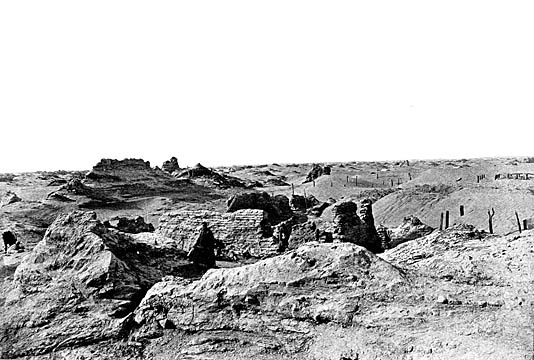
Endere
the Tang Fort from the inside
On the morning of November 1st our camp separated. Ram Singh, the Surveyor, was sent south to Niya and Sorghak with instructions to resume his triangulation along the foot of the great Kun-lun range. I myself with the rest of my party set out for the high sands due east in order to revisit the Endere tract before moving on to Charchan. In 1901 I had explored there the ruins of an ancient fort and Stupa.
A curious acquisition made during my stay at the Niya site supplied a special reason. Sadak, a young cultivator from the Mazar working with my party, had on hearing of my intended move to Endere told me of a `Takhta' he had come upon a year or two at Endere.
I was surprised to find that it was a fairly well preserved tablet of a rectangular Kharoshthi document. The writing clearly proved that it belonged to the same early period as the wooden documents of the Niya site, i.e. the third century A.D. Yet my own finds in the ruined fort of Endere in 1901 had established the fact of this site having been occupied at the beginning of the eighth century A.D. and abandoned to the desert soon after.
.... After searching the desert west of the Endere river for six wearing days and finding only a few primitve houses, pot shards and no sriptures Stein returns to the close proximity of the fort. There, in a former Buddhist temple, he recovers the package of four oblong tablets shown below. An excavation of a house produces a fireplace but nothing more exciting. Disappointed Stein decides to move on towards Charchen.....
|
|
|
On the frosty but brilliantly clear morning of the November 13, 1906
I paid off my Niya labourers, new and old, and saw them set out in
great glee for the four days' tramp to their homes. Two days later,
on November 15th, 1906 we set out for the journey to Charchan, which
we were to cover in six marches, just as old Hsüan-tsang had done.
It was the same silent uninhabited waste he describes between Niya
and Char-chan, with the drift sand of the desert ever close at
hand.
Desert
Cathay
Charchan
Nov 17-
23,1906
The brief halt in Charchen, which was all I could afford, proved a pleasant and refreshing change from the last five weeks' desert journeyings for both men and animals. There was plenty of dry lucerne for the ponies to revel in after all the hard fare on reeds and thorny scrub. The camels, too, found a treat after their own fashion on the foliage of the Jigda trees, withered as it was by the frosts.
The freshly hired camels and the supplies we needed for the journey
to Charklik had been secured in good time along with the men's winter
equipment. There were no antiquarian tasks to retain me, and thus I
could keep to my programme and set the caravan on the move again by
the morning of November 23rd.
Desert
Cathay
Charklik
Dec 4-6,
1906
Early on the morning of December ist I started my caravan for the two final marches to Charklik, a distance of close on fifty miles. Almost the whole of this distance lay over a desolate glacis of gravel, fringed only here and there by patches of scanty tamarisk growth and thorny scrub stretching northward.
The tasks I had to cope with during my short stay at Charklik were bound to be exacting. Within three days I had to raise in the small oasis a contingent of fifty labourers for proposed excavations ; food supplies to last them for five weeks, and my own men for at least a month longer ; and to collect as many camels as I could for the transport, seeing that we should have to carry.
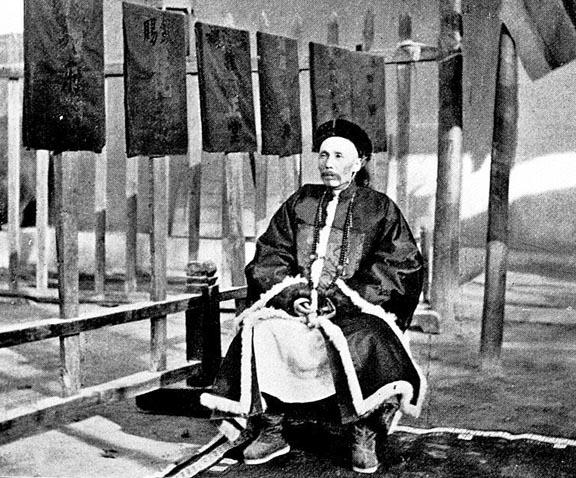
Liao
Tao-lao-ye Magistrate of Charkhlik
Fortunately Liao Ta-lao-ye, the Chinese magistrate of this forlorn district, counting in all between four and five hundred homesteads, proved most attentive and helpful. Liao was a slightly built man of about thirty-five, with pleasant and refined features of a typical Chinese cast. His charge was more of an exile, and an unprofitable one in addition, than that of any Chinese official of his rank I had yet met. So the state reception was simple enough, two Turki villagers, disguised as executioners in long red gabardines, being the chief figurants, besides a Chinese clerical attendant and the Begs escorting me. I was struck very pleasantly by my host's remarkably well-bred , manners and quiet air of authority. With the help of Chiang-ssû-yeh, ever the liveliest causeur on such occasions and a true fountainhead of genealogical knowledge in regard to every Chinese dignitary of the `New Dominions,' I soon discovered that Liao was a younger brother of Liu-chi Ta-jên whom I had met in 1901 as Amban of Yarkand.
The difficulties arising over the selection of suitable men for the Lopnor journey were great. Full of apprehensions themselves, and disheartened by the wailings of their relatives who were lamenting them as already doomed, they tried their best to get off by shamming disease or by other subterfuges. Help opportunely arrived on the second day in the persons of two hardy hunters from Abdal. Old Mullah and Tokhta Akhun, his burly companion, had in 1900-1901 seen service with Hedin around Lop-nor, and I had already from Vash-shahri sent a request ahead for them to be summoned from their homes. The Amban's messenger had fortunately found them at Abdal, and now, after having covered over sixty miles by a hard ride through day and night, they turned up cheerfully to take their places by my side.
Miran, First Visit
Dec
8 - 10, 1906
ON the morning of December 6th, 1906, I set out from Charklik for Miran and the Lop Desert. I was up long before daybreak, but it took four hours' constant urging to tear my big caravan from its flesh-pots.
A special reason for an early visit to Miran was supplied by a fragmentary leaf of paper with Tibetan writing which had been brought to me by Tokhta Akhûn, the Abdal hunter, when he joined me at Charkhlik. He declared that he had found it early in the year, while scraping what he described as the roof of a sand-filled dwelling within a ruined fort at Miran. The `find' looked undoubtedly old, and, in connexion with what Tokhta Akhûn could relate about remains of Bats' at other ruins, it determined me to spare a couple of days for a preliminary survey of the site
But in inverse proportion to the small size and roughness of the half-underground hovels was the richness of the rubbish which seemed to fill them to the roof. From the very start of the digging pieces of paper and wood inscribed in Tibetan cropped up in numbers. The profuse antiquarian haul of that first day, which it took me half the night in my tent to clean, sort, and examine, made it hard to leave behind such a mine, even for a time, without exhausting it.
As I could not afford this before my start northward, I determined in
any case to revisit the site. The vicinity of Abdal, where I proposed
to establish my base, and which would have to serve as the
starting-point for the desert journey to Tun-huang, would make it
easy to shape my plans accordingly
Desert
Cathay
Abdal
Dec 10-11,
1906
Stein decided to make Abdal his base station for the exploration of the Lopnor desert. There was plenty of water and some habitation.
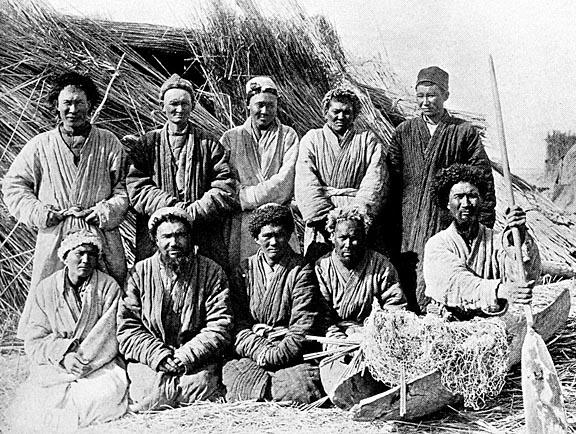
The
Lop fishermen of Abdal
Another nine miles had to be covered to Abdal, a wretched hamlet composed of fishermen's reed huts, and the most notable place for those Lopliks who still cling to their traditional manner of life.
In order to assure a timely start on the morrow I had taken care to
get a ferry constructed well ahead under Mullah's supervision, and to
ferry our camels across the Tarim long before daybreak. It was hard
for me to leave behind at Abdal my devoted helpmate Chiang-ssû-yeh.
But eager as he was to face the `Ta-Gobi,' `the Great Desert,' with
me, I knew well that his feet, unaccustomed to more than short town
walks, would be unequal to the long, trying tramps before us across
dunes and eroded ground.
Desert
Cathay
Towards Lopnor
Dec
11-16, 1906
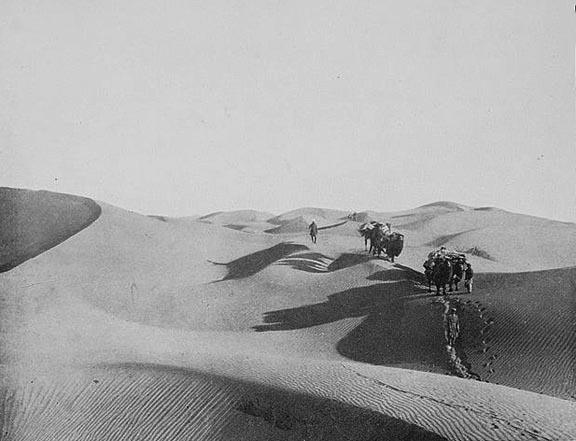
Stein's
caravan entering the Lop Desert
In spite of minimum temperatures of about eighteen degrees of frost at night the last few days had felt warmer than any since leaving Endere, a result no doubt of the much-reduced elevation and the temporary absence of wind. So when, after traversing a monotonous steppe covered with reed beds and occasional tamarisk cones for about eight miles to the north-east, we arrived by dusk at the banks of the lagoon known as Alam-khoja-köl, it was a relief to find that its marshy bed was already hard-frozen.
All the men were set to work cutting ice, and by the light of big bonfires the filling of the huge bags of coarse wool brought for the purpose from Charklik proceeded until midnight.
Next morning I roused the men by 5 A.M. ; but it was four hours later before the fully loaded column could be set in motion. The bags of ice, of which each of the eleven camels set apart for this portion of the transport was to carry three, had been made far too heavy. So all of them had to be opened again, and the surplus weight distributed as well as it might between the remaining camels carrying our supplies and indispensable baggage. In addition, we had some thirty donkeys laden with smaller bags of ice. It was my intention to make them march for two days beyond the last point where drinkable water or ice was available, and leave their ice there for a sort of half-way depot. Of course, the donkeys would need water ; but with a two days' thirst and relieved of loads they could be trusted to return quickly by the track we had come.
As to the camels, they had under Hassan Akhun's supervision been given a thoroughly long drink, six to seven big bucketfuls each, from a hole cut through the ice, and that would have to last them, for all that we knew, for some weeks. Once we had left the last lagoons and salt pools behind us, no fodder of any sort could be hoped for them until they reached the reed beds of the Altmishbulak salt springs, well to the north of Hedin's ruins
On the morning of December 15th, I had all the bags of ice which were available on the thirty donkeys carefully stacked on the north side of the highest sand cone, which we marked with a conspicuous signal staff. I arranged that the donkeys, in charge of two extra men brought for the purpose, should return as quickly as possible to the Chainut-köl base. After two days' rest there the men were to march back to our desert depot with as many donkeys as were needed to bring up the labourers' reserve food supplies, also fresh ice in the bags so far emptied, and some loads of reeds for the camels.
From Hedin's book and the sketch-map of Lop-nor accompanying it I
could also make sure that the route we had so far followed was the
same which had brought him to Abdal. I knew that, in order to reach
the ruined sites first discovered by him, we should now have to
strike a route to the north-north-east which would necessarily lead
near those he had followed in the reverse direction. But there would
be nothing to guide us, only the position of the ruins as indicated
in his route-map and the compass. So I could safely steer my course
by the compass, provided that Hedin's position for the ruins was
approximately correct, without having to fear détours and loss of
time.
Desert
Cathay
Neolithic Finds in the Desert
Dec
15-16, 1906
We had scarcely moved for more than a mile from camp, across eroded ground, when implements of the Stone Age began to appear in numbers. The first which I picked up myself were a rudely worked small axe-head in stone, then an arrow-head and knife-blade in flint. More finds of similar implements, especially of knife-blades, files, and miscellaneous flakes in flint, followed in frequent succession, as the men with me were encouraged to keep a look-out for such small objects. Some of the arrow-heads found that day were so carefully worked that even without expert knowledge I felt certain of their being neolithic.
The day's tramp across those terribly hard clay-banks and trenches, with belts of drift sand intervening, had tired men and animals badly. The heavily laden camels could not do more than about a mile and a half an hour over such ground, nor safely cross it in the dark.
By the light of the fires the men kept blazing, Hassan Akhun was busy at work with his acolytes 're-soling' unfortunate camels whose foot-pads, what with the trials of salt `Shor' and sharp-edged clay-banks, had got badly cracked. I heard the poor beasts still groaning when I went to rest about midnight.
Loulan
Dec 17-29,
1906
I had promised that morning, Dec 17, 1906, a good reward in silver to the man who should first sight a ruin. Impelled by the hope of earning it and the wish to allay their anxiety as to the end of this quest, labourers and all were moving ahead with wholly unwonted alacrity. Great was the excitement therefore when, from the top of a plateau-like Yardang which he had climbed in advance, while his animals were halted and we were setting up the plane-table about a mile from the dry river bed, one of the younger camel-men shouted that he could see a `Pao-t'ai'! All eyes were directed eastwards where he pointed, and soon I verified with my glasses that the tiny knob rising far away above the horizon was really a ruined mound, manifestly of a Stupa. What a relief it was to us all!
The men from Charklik were all buoyed up with sudden animation, and beamed as if they were already arrived at the beginning of the end of their troubles, while my own men affected a look of self-complacent assurance as if things could not possibly have happened otherwise.
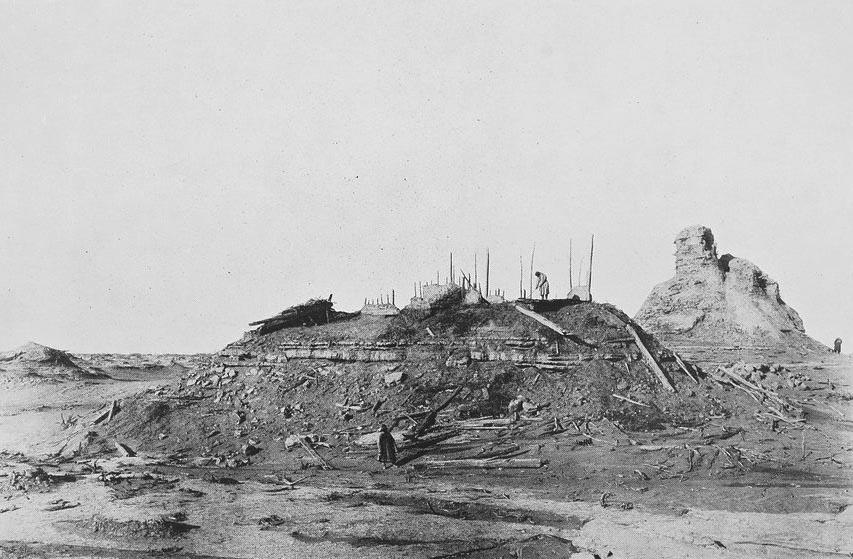
The
Stupa at Loulan at last
The distance proved nearly five miles, and though all the men moved on with alacrity, it took us two hours to cover them. On arrival I convinced myself that the large brick mound was that of a Stupa, undoubtedly the same near which Hedin had first camped on his return in 1901.
Sincere was my gratitude, too, to Hedin for his excellent mapping which, in spite of a difference of routes and the total absence of guiding features, had allowed me to strike these forlorn ruins without a day's loss, and exactly where his route map had led me to look for them. I have convinced myself with no small satisfaction that Hedin's position for this site differs from ours only by about one and a half miles in longitude and less than half a mile in latitude, a variance truly trifling on such ground.
Chance would have it that the very first ruin on which I set my men gave cause for encouraging hopes. It was the remnant of a house once manifestly much larger,occupying the top of a small and steeply eroded terrace due south of the Stupa and only some fifty yards off. Four rooms, including one over thirty feet long, could still be clearly made out by the broken walls, built of timber and wattle exactly as at the Niya site. But outside afew slips of Chinese writing, it yielded nothing of antiquarian interest.
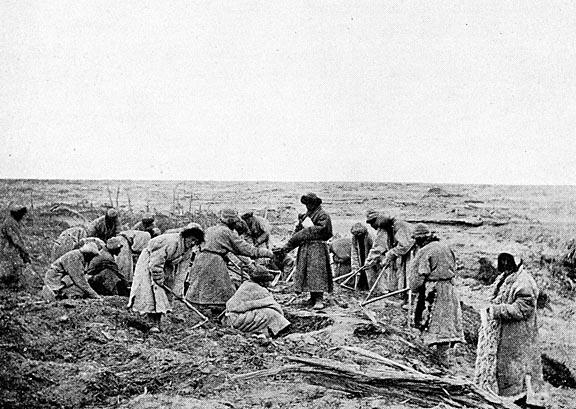
Digging
up a trash heap
In none of the ruined dwellings, however, did we strike such a rich mine as in the large rubbish heap extending near the centre of the walled area, and close to the west of the `Ya-mên'. It measured fully a hundred feet across with a width of about fifty. On the south to a height of four to five feet, gradually diminishing northwards, lay a mass of consolidated rubbish consisting of straw and stable refuse. But we had scarcely commenced digging up this unsavoury quarry when Chinese records on wood and paper cropped up in great number, especially from layers two to three feet above the ground level. The careful sifting of all these accumulations of dirt occupied us for nearly a day
By the side of so much evidence of a highly organized civilization, it was strange to come upon a small block of wood which had undoubtedly served for producing fire in the manner current at all periods among savage races.
Along one side it showed four charred holes partially sunk through the thickness of the wood and communicating with the edge by means of flat grooves which were intended to convey the spark to the tinder. Threaded on a strip of white leather, and still attached to the block through a hole was a small peg, having at one end a blunt point which just fitted the holes. It was manifestly this peg which had to be revolved in the holes. But to do this quick enough for the friction to generate fire must have required a drill apparatus, and of this I could find no remains.
However this may have been, it is clear from the fire blocks I
discovered here and at the sites of Niya and Endere, and subsequently
along the ancient frontier wall west of Tun-huang, that this
primitive method of fire production prevailed during the early
centuries of our era all along the line of Chinese advance
westwards.
Desert
Cathay
Christmas Eve 1906
In the afternon of December 24, I suddenly noticed a commotion among the groups of diggers, and shouts of 'Dakchi keldi' ('the Dak-man has come '). I could not believe my ears, but as I looked up, my eyes fell in amazement upon the familiar figure of honest Turdi, wearily trudging towards me with a bag over his shoulder.
At first the sudden apparition of my faithful `Dakchi' from Khotan seemed miraculous. On November 15th I had seen him last setting out from the Endere River with my mail bag, which he had strict orders to deliver personally to Badruddin Khan at Khotan. He had done so twelve days later. Since parting I had marched over 500 miles in the opposite direction almost without a halt—and yet here he was in the midst of this awful Lop Desert to deliver to me Badruddin Khan's devoted Salams and three Kashgar Dak bags tucked away into one !
All work stopped at once, and in the midst of an admiring circle of labourers, grateful like school-boys for an early closing of class, honest Turdi was besieged with questions. Yes, he had trudged it to Khotan and duly seen the Khan Sahib ; slept a night in his house, and been peremptorily sent off next morning with this fresh Dak, but mounted on a hired pony this time, and provided with a good fur coat. Twenty-one days had sufficed for my hardy postman to cover the thirty usual marches reckoned between Khotan and Abdal. There he found that I had left for the desert without instructions for any one how to follow me. With a mind which had more than the usual share of dog-like fidelity—and simplicity, he took this for a reason to push on and join me.
And now that by Allah's grace they had found me and escaped the peril of dying of thirst in this strange desert of clay, said Turdi, would I look at the bags from Kashgar and see that the seals of Macartney Sahib were intact in the little wooden seal-cases attached to the ends of the fastening strings ? For then he could leave them in my hands and take a good sleep by the camp fire.
It was a delightful surprise for my lonely Christmas Eve in the desert to have this big load of letters from distant friends suddenly descending upon me as if it had been brought through the air.
Across the Desert to the Tarim
Dec
29, 1906 – Jan 1907
Various considerations combined to settle the direction of my course. It would have been most tempting to move to the east along the foot of the Kuruk-tagh hills, and thus to trace if possible the ancient trade route which the ruined Chinese station had once guarded, right through to the point where it diverged from the desert track still connecting Charklik with Tun-huang. But I knew well that for a direct distance of at least 120 miles no drinkable water could now be found along the line which that route must have followed.
There was little chance of novel observations westwards, where the old trade route could be followed along the foot of the Kuruk-tagh to the Tarim ; for Hedin had marched by that line on his first visit to the ruins.
Now by striking through the desert to the south-west I should be able to survey wholly unexplored ground. At the same time this route offered the further attraction of taking me straight to the ruined fort of Merdek-shahr, which Hedin had seen in 1896 not far from the eastern lagoons of the Tarim, and which I was anxious to examine before resuming my excavations at Miran.
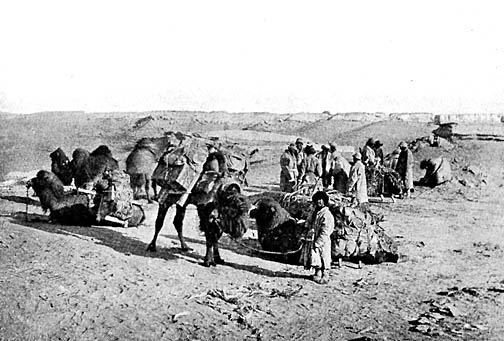
Loading
the camels at Loulan
The morning of December 29, a bright day and the first fairly calm one, saw our departure from the ancient site. All the Charklik labourers who were returning via Abdal had their accounts for wages and donkey-hire duly settled in silver and Russian gold, with an ample Bakhshish in addition.
New Year 1907
The ease with which we had so far been able to obtain fuel, and the need for keeping the camels lightly laden, had made us overlook the necessity of being prepared for this emergency. I got the men to pick up carefully in bags every scrap of decayed wood débris we could sight. But the total crop thus gathered weighed only a few pounds when dusk began to descend.
The temperature of New Year's night had fallen to a minimum of 13 degrees below zero Fahrenheit. So I felt doubly grateful that the morning of the New Year 1907 dawned upon us not merely in brilliant clearness, but without wind. There was no fire to warm myself by in the morning, and even in the sun the temperature of the day did not rise more than a few degrees above freezing-point. ' The march proved tiring to men and beasts alike ; for at intervals of two to three miles broad Dawans up to sixty feet and more in height had to be surmounted
On the morning of Jamuary 4 at last the dunes got lower and lower, and after nearly seven miles gave way to an inlet-like depression covered with dead Kumush stubble and fringed by big cones with living tamarisks. Here we first noticed the droppings of hares and deer, and the tracks made by them and smaller jungle animals. We followed the depression, manifestly the bed of a recent lagoon with traces of a flood channel cutting through it to the south-west, and after another three miles were attracted by a luxuriant bed of reeds.
While the camels fell to grazing on this with the hunger of some ten foodless days, we ascended a low sand-ridge close by in order to get a look-out.
Suddenly Aga-bergan, the carpenter, recognized a Toghrak grove in which only a year before he had helped to make a Loplik's ` dug-out,' and assured us that the lagoon of Köteklik-köl with its fishermen's station was quite near ! The men shouted with joy, and we all pushed on westwards through the thick scrub and reeds until less than half a mile beyond we stood on the north shore of the hard-frozen winding lake.
Marching westwards for about a mile and a half we crossed successive arms of the lake, all covered with ice so clear that we could see right down to the bottom, six to eight feet deep, and watch the fishes moving. Its thickness was about one foot, as measured at occasional holes which fishermen had cut to insert their nets.
Ruins of Merdek
Jan 5-7, 1907

Camp
near Merdek
Thus on striking the Tarim, or rather the Ilek, we found ourselves fully a march to the south of the Merdek ruin. This made it necessary to recover what we had lost in latitude by marching up the Ilek on January 5th. The night had been perceptibly warmer than any of those passed in the desert ; as we moved along sheltered depressions and under a bright sky, the day's tramp was quite enjoyable.By the side of a dry lagoon I sighted the clay rampart of the small circular fort od Merdek overgrown with reeds (Jan 6). Pitching camp there I devoted the day to a close examination of this modest ruin and soon found evidence of its early origin.
Insignificant as was the ruin itself, its date invested it with a
definite antiquarian and geographical interest ; for its existence at
this place proves that a branch of the Tarim must already in the
early centuries of our era have flowed close to the present line of
the Ilek, and this is a fact that was worth establishing in view of
much-discussed theories about earlier wanderings of the Tarim and its
terminal lake beds.
Desert
Cathay
Return to Charklik
Jan
10-22, 1907
Our march on January l0th was most depressing. The track representing the `high road' to Charklik now turned to the south-west and finally forsook the Tarim. The wearisome succession of marshes which we skirted all day manifestly formed the northernmost edge of the Charchan river delta.
Several of my men had suffered severely under the hardships of our desert work ; Muhammadju in particular had never ceased groaning for some days past, complaining of pains which suggested pleurisy—or a creditable imitation of it. A few days' rest under comfortable shelter might restore the physical endurance of my caravan, and only Charklik could afford that.
There was a another even more compelling reason. Our caravan was caught up by a mounted messenger despatched from the Charklik Ya-mên. The cover which he brought proved to be a telegram from Macartney, sent to Kara-shahr in reply to my letter of November 15th, informing me that the sum of 1500 Taels in Chinese silver, which I had asked him to place at my disposal through the good offices of the Tao-t'ai of Ak-su, was to be available for me, not at Charklik where the local administration was manifestly unable to raise such a sum, but at the treasury of Kara-shahr.
Now Karashar situated on the great high road from Kashgar to Urumchi, lay some three hundred and fifty miles away to the north. The telegram had taken over a fortnight to reach me from there, and while I fully appreciated the saving of time effected by the use of the wire between Kashgar and Kara-shahr, I could not help feeling disappointed on finding from an accompanying Chinese-Turki epistle that the prefect of Kara-shahr, evidently fearing risks about the transmission of the silver, had left it to me to arrange for fetching it. It was practically impossible to achieve this without returning first to Charklik; and as it was important that I should receive my reserve of Chinese silver horse-shoes before setting out through the desert for Tun-huang, I decided to make my way to Miran via Charklik.
So on the morning of January 16th, to the great relief of my myrmidons, I changed our course at right angles and headed for Charklik due south. It was a long and dreary day's march. Finally, we reached in the dark of Jan. 16 Charklik, and after a total march of some twenty-six miles found a hearty welcome and shelter in our old host's house.
My stay at Charklik gave my men the rest which they amply deserved and needed. But I myself found the five days to which, in spite of my efforts, it dragged out, almost too short for all the tasks there were to get through. An early visit to the Ya-mên, where Liao Ta-lao-ye greeted me with the cordiality of an old friend, allowed me to arrange for the rapid progress of Ibrahim Beg, who was to proceed to Kara-shahr and fetch my silver reserve with all possible speed. Using freely all official resources, the journey
to and fro could not be accomplished in less than a month, and it was important that my own start for Tun-huang should not suffer delay on that score.
On the morning of January 22nd I was free at last to start back to
Miran with diggers and supplies all complete, but my caravan slightly
reduced in men and animals.
Desert
Cathay
Miran II
Jan 22 –
Feb 11, 1907
Our marches to Miran lay along the route followed before and were uneventful. We reached it on Jan 23 at night. Dear Chiang-ssû-yeh and a dozen of Lopliks from Abdal gave us a joyful welcome. In obedience to my original order they had camped here patiently for a week in readiness for fresh excavations. It was delightful to be reunited once more to my devoted Chinese helpmate.

Chiang-ssŭ-yeh's
tent at Miran
Tibetan Documents
It did
not take long to get proof that the ruined fort was likely to fulfil
the promise held out by the previous experimental digging. From a
single small apartment, measuring only some eleven by seven feet, and
still retaining in parts its smoke-begrimed wall-plaster we recovered
over a hundred documents. The rubbish reached in places to a height
of close on nine feet, and right down to the bottom the layers of
refuse yielded in profusion records on paper and wood. With one
remarkable exception to be described farther on they were all in
Tibetan. The total number of documents amounted in the end to more
than a thousand.
Desert
Cathay
Winged “Angels” in a Buddhist Shrine!

Colossal
Stucco Head of a Budda from Shrine M, photo Serindia
On January 29th the advanced state of the fort excavations allowed me to take a portion of my band of diggers across to the ruined temple a little over a mile away to the north-east, where experimental clearing in December had disclosed some sculptural relics of manifestly early type. It was a bitterly cold day. The minimum temperature was 37 degrees below freezing-point ; and in the piercing north wind it seemed as if this would never rise at all. But all the discomforts from cold, wind, and the dust clouds attending work in the trenches were forgotten at times over the interesting results of the digging.
Meanwhile I lost no time in starting work on January 31st at a group of ruined mounds which remained unexplored, about a mile and a quarter west of the fort. The cursory inspection I had made of a cluster of five of them on my first approach to the site, had left the impression that they were much-decayed ruins of Stupas of the usual type.

Dado
of Angels from the rotunda of Shrine M, photo Serindia

Iranian
influence in a wall painting from Buddhist Shrine M (3rd cent
AD)
photo Desert
Cathay
The clearing was still proceeding in the afternoon when from the
north and east segments of the circular passage fragments of painted
stucco cropped up rapidly. It was evident that the interior walls of
the cella had once been adorned with frescoes. Yet, when the digging
there had reached a level of about four feet above the floor and a
delicately painted dado of beautiful winged angels began to show on
the wall, I felt completely taken by surprise.
How could I have
expected by the desolate shores of Lop-nor, in the very heart of
innermost Asia, to come upon such classical representations of
Cherubim ! And what had these graceful heads, recalling cherished
scenes of Christian imagery, to do here on the walls of what beyond
all doubt was a Buddhist sanctuary ?
I was still wondering how to
account for the distinctly classical style in the representation of
these Cherubim and the purport of . this apparent loan from early
Christian iconography, when the discovery of a ` Khat,' announced by
a shout from the men, supplied definite palaeographic evidence for
the dating. From the rubble of broken mud-bricks and plaster filling
the passage on the south there emerged in succession three large
pieces of fine coloured silk, evidently belonging to what had once
been a votive flag or stream. [It later turned out that the Karoshthi
text were prayers for the health of a number of persons and their
relatives, all the names given being, significantly enough, of either
Indian or Iranian origin.]
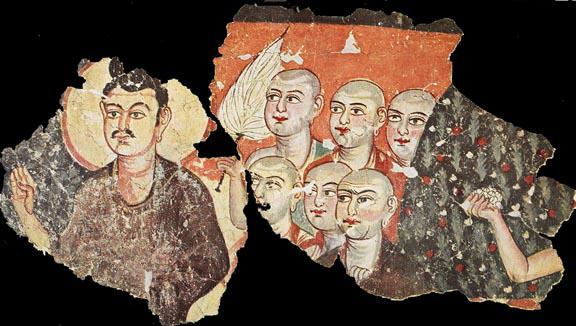
Wall
painting of Hinyana monks with strongly Indian features
Buddhist
Shrine M. Photo Serindia
|
|
|
There still remained the ticklish question how to lift these terribly
brittle panes of mud plaster on to my padded boards without letting
them break into fragments or injuring the delicately painted surface.
A board lightly padded with cotton wool, under large sheets of that
tough Khotan paper, which I never ceased blessing as the best packing
stuff produced in Central Asia, was pressed gently and evenly against
the front surface of the fallen fresco. Next a large sheet of stout
tin, which Ram Singh had managed to improvise out of carefully stored
empty cases and to stiffen with thin iron bands, was slowly
introduced with a sawlike action at the soft back of the broken
panel.
When once firmly held from front and back, the piece of
wall plaster, however large, could be safely tilted forward until,
with its painted surface downwards, it came to lie flat on the padded
board, and could be moved without risk.
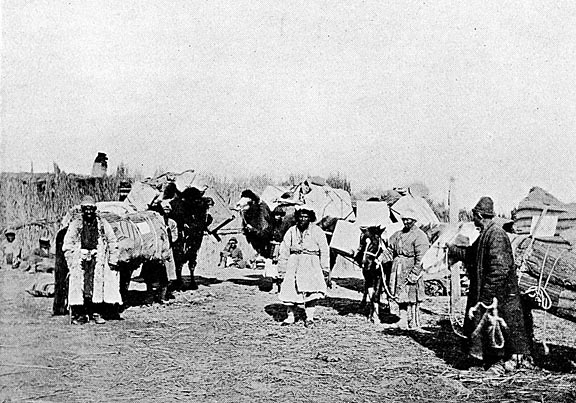
Camel
caravan with Miran finds leaving for Kashgar
The odds against these brittle panes of mud plaster travelling safely
to London seemed small. The time for true relief arrived only when,
just three years after that trying exploit at Miran, the cases came
to be opened at the British Museum. Then all doubts about the success
of the hazardous experiment were lifted from my mind. How delighted
my eyes were to behold these fine art relics, probably the most
fragile ever transported over such a distance and over such ground,
brought to safety practically in the same condition as when I had the
good fortune to see them rise from their grave of long centuries in
that dismal wind-swept desert of gravel!
Detailed discussion of
the wall paintings: Desert
Cathay
On the Way
to Tunhuang
Feb 11 - March 2,
1907
Interlude at Abdal
Feb 12
- Feb 21, 1907
A judicious adjustment of pay arrears and rewards to be disbursed at Kashgar gave hope that thr convoy of antiques would be safely delivered. But in spite of continuous driving and pushing it was only on the seventh day from my arrival at Abdal that I saw the caravan, which included also Turdi, the plucky Dak-man, start for their two months' journey to Kashgar.
To get my own caravan ready for the long desert crossing cost simultaneous and quite as great efforts.The provision of a month's supplies for men and animals was a big job, and still more the arrangements for their transport. My united party counted in all thirteen persons, eleven ponies for mounts, and eight camels.
Ponies could not do without fodder, and how to carry enough of this for a month with the rest of the men's food was the crux. To procure camels for the purpose proved impossible. The few Charklik camels which I had secured for the march across the Lop-nor Desert were still too weak from the fatigues undergone to be taken along without imminent risk of a break-down, which would have seriously hampered us when once started on the long desert journey.
In the midst of all this bustle which the resident Lopliks, young and old, seemed to enjoy hugely, there arrived to my relief honest hard-riding Ibrahim Beg with the fifteen hundred Sers of silver in Chinese ' horse-shoes,' for which I had despatched him less than a month before to the Kara-shahr Ya-mên. He had covered the distance there from Charklik, more than 33o miles, within seven days on post-horses, but was obliged to spend fully twice as much time on the return journey owing to the protective company of two Chinese Ya-mên attendants.
Before taking over the quaint horse-shoes,' big and small, I had them, of course, weighed,though I knew that I could trust Ibrahim Beg implicitly in a matter of this sort. The operation was performed with one of those neat and cleverly designed pairs of ivory scales which work on the adjustable lever principle.
When Chiang-ssû-yeh with nimble hands and inexhaustible patience had finished all the weighing, it was found that the number of ounces of silver was short by an amount equivalent to something over 40 rupees. - The explanation was that payment had been made on the official scale of weights accepted at Turkestan treasuries, whereas my own scales were supposed to conform to the weights in use for trade transactions in the `New Dominion.'
It was ten o'clock on February 21 before I could get the whole column, including close on forty donkeys, to move off. The settling of final accounts and claims kept me back for another three hours. But at last I, too, could ride off, after giving much-prized little European presents to the women-folk and children of my host. Chiang-ssûyeh during his long stay in December had made himself a great favourite with the little ones and was visibly affected by the parting.
Following theGreat Wall
Feb
14 - Mar 12, 1907
On his way to Dunhuang Stein discovered the sand-buried remains of
the eastern-most end of the Chinese Great Wall: heavily eroded towers
and gates which defended Chinese Kansu from the Xi-Xia and other
Central Asian tribes. He made the first surveillance of this bulwark,
the antiquarian yield consisted only of a few Tang documents. I omit
this part of his description and refer the reader to the facsimile
edition:
Desert
Cathay
Tunhuang-Dunhuang
March
12 – 24, 1907
modern Pinyin spelling: Dunhuang
On the morning of March 12th, 1907, we were prepared to make our entry into Tun-huang town. All the men had been looking forward eagerly to our arrival. But circumstances seemed to combine to deprive it of all state and even comfort. An icy gale was blowing from the east, and cutting as it was among the trees and houses, we congratulated ourselves inwardly that we had escaped it in the open desert. But what, somehow, seemed worse was that, though the town was said to be only some twenty Li, or about four or five miles off, no reply whatever was forthcoming to the elegant epistle which Chiang-ssû-yeh, at the very time of our reaching the oasis, had despatched to the Ya-mên, along with that imposing Chinese visiting-card of mine on red paper.
So after some useless wait we set out for the town. Our atlases show it as Sha-chou, `City of Sands' ; but to the local Chinese it is best known by its ancient name of Tun-huang, dating from Han times.
At the magistrate's Ya-mên we met at last a small crowd of idlers, and directed by them, made our way past a couple of picturesque half-decayed temples with fine old wood-carving to the Sarai suggested for our residence. It proved a perfectly impossible place, so filthy and cramped that I decided at once rather to camp in the open.
At last, half a mile or so from its south gate, I discovered a large
orchard with a lonely house at one end which looked as if it had seen
better days. On invading its precincts we found it still occupied,
but luckily by people who were ready to find room for so big a party
as ours.
Cheerfully toddling about on their poor little bound feet
the Chinese ladies huddled as much as they could of their household
goods into one small block of rooms, while we were welcome to make
what use we could of the rest.
At last one of the Turki traders
came to the rescue by changing a few Taels of silver into long
sausage-like strings of copper 'cash ' at a rate which suited his
fancy. Even then it took hours before fuel, fodder, etc.,
arrived.
Desert
Cathay
The “Caves of the Thousand
Budhas”
also known as the “Magao Caves”
First
Visit
March 16, 1907
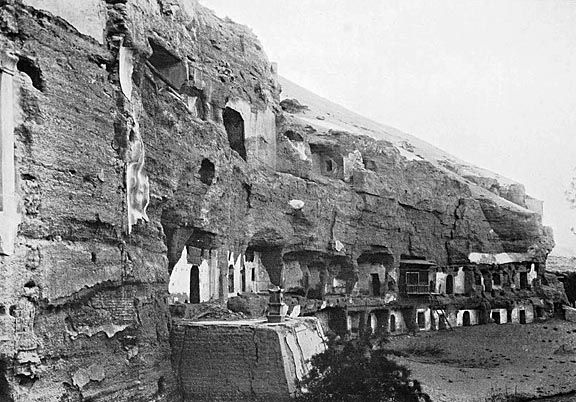
On the 16th of March I could at last pay my first visit to the famous
cave temples to which my thoughts had turned for so long from afar.
Chiang-ssû-yeh, Naik Ram Singh, and one of Lin Ta-jên's
subordinates were to be my companions.
Desert
Cathay
I caught sight of the first grottoes. A multitude of dark cavities, mostly small, was honeycombing the sombre rock faces in irregular tiers from the foot of the cliff, where the stream almost washed them, to the top of the precipice.

Here and there the flights of steps connecting the grottoes still showed on the cliff face. But in front of most the conglomerate mass had crumbled away, and from a distance it looked as if approach to the sanctuaries would be possible only to those willing to be let down by ropes or to bear the trouble and expense of elaborate scaffolding. The whole strangely recalled fancy pictures of troglodyte dwellings of anchorites such as I remembered having seen long, long ago in early Italian paintings.

Dunhuang,
central part of the Caves
At once I noticed that fresco paintings covered the walls of all the grottoes or as much as was visible of them from the entrances. ' The Caves of the Thousand Buddhas' were indeed tenanted, not by Buddhist recluses, however holy, but by images of the Enlightened One himself. All this host of grottoes represented shrines, and I hastened eagerly to take my first glance at their contents. Yet there was no human being about to receive us, no guide to distract one's attention.
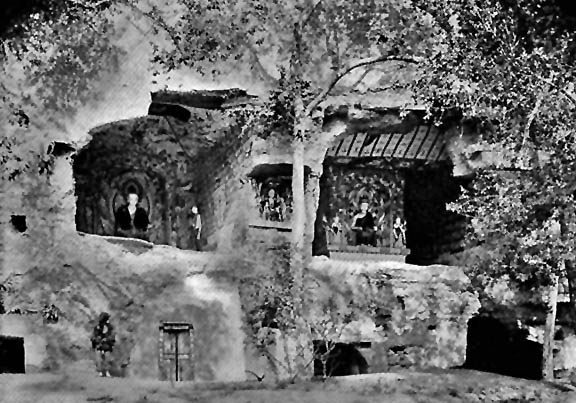
In
many caves their front porches had fallen away so that their frescoes
were exposed
All the wall faces were covered with plaster bearing frescoes. Those
on the passage walls ordinarily represented rows of Bodhisattvas
moving in procession or seated in tiers. Within the cellas the
paintings were generally arranged in large, elaborately bordered
panels, either singly or, where the wall surface was extensive, in a
series. In the centre of these there appeared mostly figures of
Buddhas, singly or in groups, surrounded by divine worshippers and
attendants in many varied forms and poses. There were scenes from the
Buddhist heavens, from legends in which Buddhas or saints figured,
representations of life in their places of worship, etc.
Desert
Cathay
As I passed hurriedly from grotto to grotto, faithfully followed by
my literatus, we were at last joined by one of the local priests I
had been looking out for. It was a young ' Ho-shang,' left in charge
of the conglomeration of small houses and chapels which occupied a
place amidst some arbours and fields facing the south end of the
grottoes. He was a quiet, intelligent fellow, quick at grasping what
attracted my interest, and as unobtrusive a cicerone as one could
wish for.
Our guide readily took us to the temple containing a big
Chinese inscription on marble which records pious works executed here
in the T'ang period, and subsequently to the two shrines where
smaller epigraphic relics dating from the Sung and Yuan dynasties are
preserved.
At Tun-huang I had first heard vague rumours about a great hidden deposit of ancient manuscripts which was said to have been discovered accidentally some years earlier in one of the grottoes. And the assertion that some of these manuscripts were not Chinese had naturally made me still keener to ascertain exact details.These treasures were said to have been locked up again in one of the shrines by official order. The absence of the Taoist priest in charge of the manuscripts made it impossible to start operations at once. But the young monk was able to put us on the right track. So I soon let him be taken aside by Chiang Ssû-yeh for private confabulation.
The cache of manuscripts was in a large shrine farther north, bearing
on its walls evidence of recent restoration. The entrance to that
cave had been formerly blocked by fallen rock-débris and drift sand.
After this had been cleared out, and while restorations were slowly
proceeding in its cella and antechapel, the workmen engaged had
noticed a crack in the frescoed wall of the passage between them.
Attracted by this they discovered an opening leading to a recess or
small chamber hollowed out from the rock behind the stuccoed wall to
the right. It proved to be completely filled with manuscript rolls
which were said to be written in Chinese characters, but in a
non-Chinese language. The total quantity was supposed to make up
several cart-loads.
The priest was away in the oasis, apparently
on a begging tour with his acolytes. Chiang Ssû-yeh had thus no
chance to pursue his preliminary enquiries further. But, fortunately,
the young Ho-shang's spiritual guide, a Sramana of Tibetan
extraction, had borrowed one of the manuscripts for the sake of
giving additional lustre to his small private chapel, and our
cicerone was persuaded by Chiang Ssû-yeh to bring us this specimen.
It was a beautifully preserved roll of paper, about a foot high and
perhaps fifteen yards long, which I unfolded with Chiang-ssû-yeh in
front of the original hiding-place. The writing was, indeed, Chinese,
but my learned secretary frankly acknowledged that to him the
characters conveyed no sense whatever.
Desert
Cathay
Opening the Secret Chamber
May 21 - 28, 1907
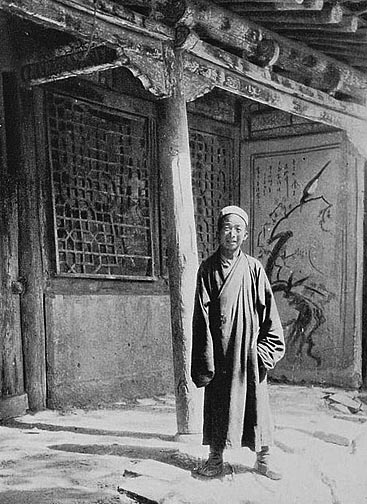
Wang
Tao-shih the priest in charge of the manuscripts
Chiang Ssû-yeh councelled to proceeded slowly, he had induced Wang Tao-shih, the priest, who had come upon the hidden deposit, to await my arrival instead of starting on one of his usual tours in the district to sell blessings and charms, and to collect outstanding temple subscriptions.
Next morning I started what was to be ostensibly the main object of my stay at the site, the survey of the principal grottoes, and the photographing of the more notable frescoes. Purposely I avoided any long interview with the Tao-shih, who had come to offer me welcome at what for the most of the year he might well regard his domain. He looked a very queer person, extremely shy and nervous, with an occasional expression of cunning which was far from encouraging. It was clear from the first that he would be a difficult person to handle.
I thought it best to study his case in personal contact. Accompanied by Chiang Ssû-yeh I proceeded in the afternoon to pay my formal call to the Tao-shih, and asked to be shown over his restored cave-temple. It was the pride and the mainstay of his Tun-huang existence, and my request was fulfilled with alacrity. As he took me through the lofty antechapel with its substantial woodwork, all new and lavishly gilt and painted, and through the high passage or porch giving access and light to the main cella, I could not help glancing to the right where an ugly patch of unplastered brickwork then still masked the door of the hidden chapel.
Meanwhile
I was glad enough to propitiate the young Buddhist priest with an
appropriate offering. I always like to be liberal with those whom I
may hope to secure as `my own ' local priests or `Purohitas ' at
sites of ancient worship. But, unlike the attitude usually taken up
by my Indian Pandit friends on such occasions, when they
could—vicariously—gain `spiritual merit ' for themselves,
Chiang-ssû-yeh in his worldly wisdom advised moderation. A present
too generous might arouse speculations about the possible ulterior
objects. Recognising the soundness of his reasoning, I restricted my
`Dakshina,' or offering, to a piece of hacked silver, equal to about
three rupees or four shillings. The gleam of satisfaction on the
young Ho-shang's face showed that the people of Tun-huang, whatever
else their weaknesses, were not much given to spoiling poor
monks
Desert
Cathay
Late at night a few days later Chiang Ssû-yeh groped his way to my
tent in silent elation with a bundle of Chinese rolls which Wang
Tao-shih had just brought him in secret, carefully hidden under his
flowing black robe, as the first of the promised ` specimens.' The
rolls looked unmistakably old as regards writing and paper, and
probably contained Buddhist canonical texts; but Chiang Ssû-yeh
needed time to make sure of their character. Next morning he turned
up by daybreak, and with a face expressing both triumph and
amazement, reported that these fine rolls of paper contained Chinese
versions of certain `Sutras' from the Buddhist canon which the
colophons declared to have been brought from India and translated by
Hsüan-tsang himself.
Desert
Cathay
Later that day I found the priest evidently still combating his scruples and nervous apprehensions. But under the influence of that quasi-divine hint to Hsüan-tsang he now summoned up courage to open before me the rough door closing the narrow entrance which led from the side of the broad front passage into the rock-carved recess, on a level of about four feet above the floor of the former.

Cave
14 filled with scrolls
The sight of the small room disclosed was one to make my eyes open
wide. Heaped up in layers, but without any order, there appeared in
the dim light of the priest's little lamp a solid mass of manuscript
bundles rising in places to a height of nearly ten feet, and filling,
as subsequent measurement showed, close on 500 cubic feet. The area
left clear within the room was just sufficient for two people to
stand in. It was manifest that in this 'black hole ' no examination
of the manuscripts would be possible, and also that the digging out
of all its contents would cost a good deal of physical labour.
The
Tao-shih had summoned up courage to fall in with my wishes, on the
solemn condition that nobody besides us three was to get the
slightest inkling of what was being transacted, and that as long as I
kept on Chinese soil the origin of these `finds ' was not to be
revealed to any living being. He himself was afraid of being seen at
night outside his temple precincts. So the Chiang Ssû-yeh, zealous
and energetic as always, took it upon himself to be the sole carrier.
For seven nights more he thus came to my tent, when everybody had
gone to sleep, with the same precautions, his slight figure panting
under loads which grew each time heavier, and ultimately required
carriage by instalments. For hands accustomed only to wield pen and
paper it was a trying task, and never shall I forget the good-natured
ease and cheerful devotion with which it was performed by that most
willing of helpmates.
From
the first I
was
certain that the contents of the hidden chapel must have been
deposited in great confusion around the Xi Xia invasion in 1063 AD,
and that any indications of the
original
position of the bundles at the time of discovery, had been completely
effaced when the recess was cleared out, as the Tao-shih admitted, to
search for valuables.
It was mere chance, too, what bundles the
Tao-shih would hand out to us. Nor was my hurried search the time for
appreciating the import of all that passed through my hands.
It
was from those 'mixed ' bundles chiefly that manuscripts and detached
leaves in Indian script and of the traditional Pothi shape continued
to emerge. By far the most important among such finds was a
remarkably well preserved Sanskrit manuscript on palm leaves, some
seventy in number, and no less than twenty inches long
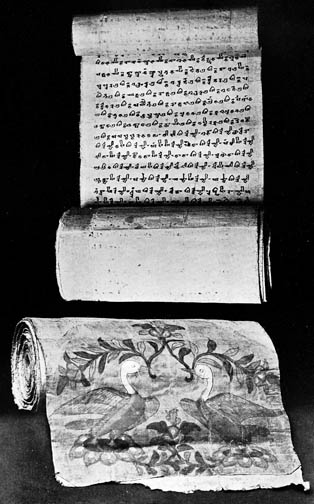
A
70-foot long scroll in Brahmi script, photo
Among the Brahmi scriptures was a gigantic roll of paper, over 70 feet long, and about one foot wide, entirely covered on its inner side with Brahmi writing in a fair upright hand of what scholars know as the Gupta type. A painting on the top of the outer side showed two cleverly drawn geese standing on lotuses and facing each other. When hastily examining it in part, I could find only invocation prayers in corrupt Sanskrit of a kind familiar to Northern Buddhism.

The
oldest-known block-printed text, an edition of the Diamond Sutra
(dated 864 AD)
Greatly
delighted was I when I found that an excellently preserved roll with
a well-designed block-printed picture as frontispiece, had its text
printed throughout, showing a date of production corresponding to 860
A.D. Here was conclusive evidence that the art of printing books from
wooden blocks was practised long before the conventionally assumed
time of its invention, during the Sung period, and that already in
the ninth century the technical level had been raised practically as
high as the process permitted.
Desert
Cathay
He agreed to let me have fifty well-preserved bundles of Chinese text
rolls and five of Tibetan ones, besides all my previous selections
from the miscellaneous bundles. For all these acquisitions four
horse-shoes of silver, equal to about Rs.5oo, passed into the
priest's hands; and when I surveyed the archaeological value of all I
could carry away for this sum, I had good reason to claim it a
bargain.
When later on it came to the packing, the manuscript
acquisitions needed seven cases, while the paintings, embroideries,
and other miscellaneous relics filled five more.The packing of these
was a very delicate task work was impossible in the caves. There was
some little trouble about getting enough boxes without exciting
suspicion at Tun-huang. Luckily I had foreseen the chance and
provided some 'empties ' beforehand. The rest were secured in
disguise and by discreet instalments. So everything passed off
without a hitch.
When I finally said good-bye to the 'Thousand
Buddhas,' his jovial sharp-cut face had resumed once more its look of
shy but self-contented serenity. We parted in fullest amity.
I
may anticipate here that I received gratifying proof of the peaceful
state of his mind when, on my return to An-hsi four months later, he
agreed to let depart for that 'temple of learning' in the distant
West another share of the Chinese and Tibetan manuscripts in the
shape of over two hundred compact bundles.
My
time for feeling true relief came only when all the twenty-four
cases, heavy with manuscript treasures rescued from that strange
place of hiding, and the five more filled with paintings and other
art relics from the same cave, had been deposited safely in the
British Museum.
Desert
Cathay
A Profusion of “Silk Banners”
While Stein's passion lay with the manuscripts he inherited a number of beautiful large “banners” – thankas painted on diaphanous pieces of silk. Some are Chinese others Tibetan. He is not a specialist in this discipline and his explanations are tentatative. I reproduce a few.
|
|
|
|
|
|
|
|
Frescoes in the Caves
March-May,
1907

A
row of Boddisattvas
All the wall faces were covered with plaster bearing
frescoes. Those on the passage walls ordinarily represented rows of
Bodhisattvas moving in procession or seated in tiers. Within the
cellas the paintings were generally arranged in large, elaborately
bordered panels, either singly or, where the wall surface was
extensive, in a series. In the centre of these there appeared mostly
figures of Buddhas, singly or in groups, surrounded by divine
worshippers and attendants in many varied forms and poses. There were
scenes from the Buddhist heavens, from legends in which Buddhas or
saints figured, representations of life in their places of worship,
etc.
Discussion: Desert
Cathay
Stein reproduces a large number of frescoes in the caves. For his general audience they, not his incunabula, were the sensation of his visit to Dunhuang, which is after all the largest repository of Central Asian Buddhist painting (app. 500 caves!) spanning 900 years between 446 AD and 1300 AD. The contemporary caves in China proper surpass Dunhuang in their sculptural decorations, but they are not frescoed. Buddhist painting was a direct import from India, Persia, Nepal, and non-Chinese Western Asia. It is no surprise that the periods of flourishing painting in Dunhuang coincide with periods of dominance by Western “barbarian” tribes in Turkestan. Even the painting during the extended Chinese military presence there during the Tang dynasty was influenced by color schemes totally alien to Chinese sensibilities.
Dunhuang 1983
In addition, Stein's black-and-white
photographs of the frescoes give only a very dim
impression of their riotous, psychedelic colors. I visited
Dunhuang for 3 days in October 1983. - Annotated color photos from
this visit are found at:
Dunhuang
1983
From Anhsi to Kanchou
through
the Nan-shan Mountains
modern Pinyin spelling: Anxi
and Zangje
June 17-24, 1907
The hot summer was approaching and Stein had decided to explore the Nan-Shan mountains to the south. He had expected to find help and the necessary provisions at Anhsi, the local district headquarters.
The provision of the transport needed for my move southward seemed a
formidable affair, and I had not been long at An-hsi before I
realised how very limited were the resources of the place in spite of
its magistrate's high-sounding title. Apart from the struggling
hamlets in the wide, scrub-covered plain, which was very slowly
recovering from the terrible ravages of the Tungan inroads, the
district in his immediate charge comprised but a few scattered
villages far away in the foot-hills, where his orders had scant
chance of being obeyed with promptness. Fortunately I was able to use
the six days which it cost to surmount these obstacles not only for
many tasks of writing, but also for interesting archaeological
observations in the neighbourhood (another part of the Great Wall and
the caves of Wan Fo Hsia).
Desert
Cathay
Caves of Wang-Fo-Hsia
June 30 - July 3,1907
South-east of Dunhuang is a second cave monastery, visited by Stein. It is newer and not as interesting as the Magao caves. Being in a desolate state the complex is closed to foreigners at this time - and especially to foreign "experts" who inquire at the Chinese International Tourist Service ( CITS) how to get there. The modern Chinese name is Dongbafuxiang
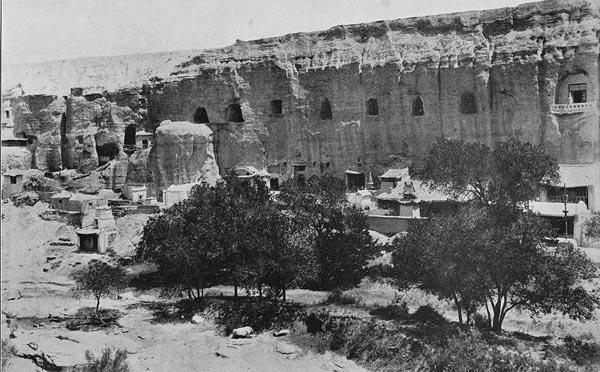
Caves
at Wang-fo-hsia
Known
as Wang-fo-hsia, or the ` Valley of the Myriad Buddhas.' I knew that,
in spite of its grandiloquent name, this sacred site could not
compare in importance with the `Thousand Buddhas' of Tun-huang.
We
reached the site on June 1,1907. The next two days were busily used
for the examination and photographing of the shrines. Though executed
on a distinctly smaller scale, and probably commenced at a somewhat
later date, they resembled the cave-temples of Tunhuang so closely in
all essential points of architectural disposition and artistic
decoration that a summary description will suffice.
Desert
Cathay
Suchou-Jiuquan
July 23- 28 + Sep 16, 1907
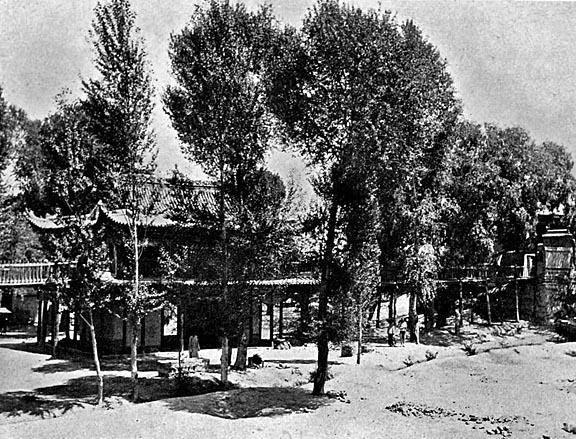
Chiu-ch'üan,
the `Spring of Wine'
A delightful surprise awaited me at the end of the dusty ride. On terraced ground, above a large reed-filled basin filled by the limpid water of a bubbling spring, I found a fine arbour and garden lined by temple halls , and airy colonnades connecting them (Fig. 228). For a moment I felt in doubt whether I had been suddenly carried back to the shore of a Kashmir lake or to an old Moghul country-seat in the Lahore Campagna. Features of both these surroundings, which happy times of the past had endeared to me, seemed to mingle in the pleasantest fashion at Chiu-ch'üan, the `Spring of Wine,' as this charming spot has been known since ancient times. Once it gave its name to the city itself.
The six days which passed before I could set out for the mountains were both busy and pleasant. But space suffices only for the briefest account of them. Exchange of state visits with the chief dignitaries of Su-chou absorbed most of the first day. The Tao-t'ai who, under the arrangements made by the Peking Legation and the Wei-wu-pu or Foreign Office, was to act as my banker while in Kan-su. I found him to be a quiet old gentleman, much bent by illness and the burden of years. Conversation with him was bound to lag a little; for his faint lisping talk was often difficult to catch even for Chiang-ssû-yeh's quick ear. The main point was that everything about my credit of 6000 Taels, or roughly £1000, was in due order.
The Nan-Shan Mountains
Pinyin: Qilian Shan
July 28 – Aug 26, 1907
The
morning of July 31st saw at last our start into the mountains. The
animals did not arrive till 8 A.M., and it took two hours before they
were loaded. But in the joy of seeing the move made in earnest I did
not much mind the delay nor the trouble which the weighing out of
silver for advances to pony-men gave me.
Desert
Cathay
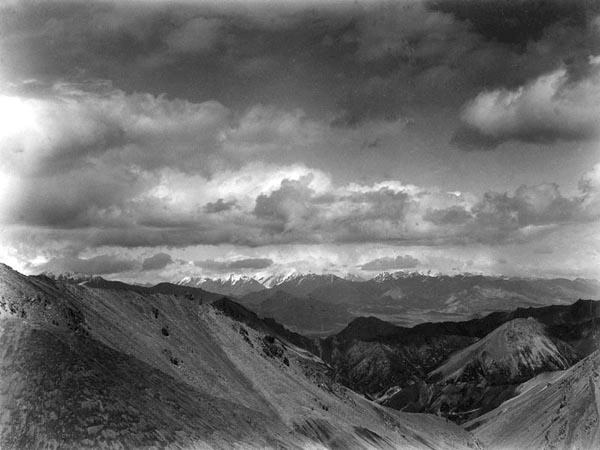
The
Nanshan from Huoning Pass, Aug 5, 1907
On the morning of August 5th, a heavy white fog hid the whole of plateau and mountains until 7 A.M. But when the sun broke through, the vistas were inspiring. Near by the eye was refreshed by the sight of young flowers, among them many edelweiss, just appearing amongst the scanty tufts of grass and moss. The men needed the forenoon to dry their clothes in the sun and to cook their food for which fuel had been lacking in the evening, and I used these hours of brilliantly clear sky to ascend to a dominating point of the watershed, about 14,000 feet high. From there I secured a complete panorama of this strange amalgam of high ranges, bright red downs, and boggy uplands.
Mutiny on the March
Mid August 1907
At one point, when provisions became low, Stein's Chinese pony-men refused to eat the roasted barley he had offered them and went on strike.
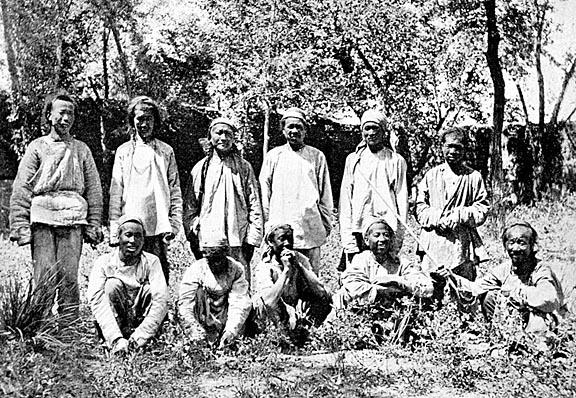
The
"rioters". The old man at right points with his stick to
their leader of the mutiny.
The natural difficulties unavoidable in such inhospitable solitudes were considerably increased by the helplessness of our Chinese pony-men, and what I may politely call their deep-rooted `aversion to taking risks.' Now these dreaded mountains were to them full of risks, imaginary as well as real; and instead of using such intelligence as plentiful opium-smoking had left them to guard against these, they tried their best to run away from them altogether. Chiang and myself used to talk of them as our `senile babies'. Like aged men taught to suffer by much hard experience they saw risks everywhere, from avalanches, quicksands, sudden floods, robbers, even dragons; yet they were like babes in a wood when it came to obviating any of them.
At first, they persisted in refusing to touch the barley, declaring
that it was impossible food for humans. The argument that I ate it
myself daily as porridge made little or no impression until
Chiang-ssû-yeh's diplomacy came to the rescue. He had done his best
all along to look after and cheer the refractory pony-men, and had
slowly acquired some mild influence over them. He now explained to
them gravely that I, whom they curiously enough readily credited with
a good deal of Chinese learning—though I could not give adequate
expression to it in their colloquial dialect—had found a classical
passage declaring barley a permissible substitute for one of the six
orthodox food-stuffs. This made due impression on their minds,
permeated by time-honoured prejudices and conventions; but Chiang had
bravely to set an example by eating it himself before they reconciled
themselves to a diet of roasted barley.
Desert
Cathay
Kanchou-Zangye
Aug
26 – Sep 3, 1907
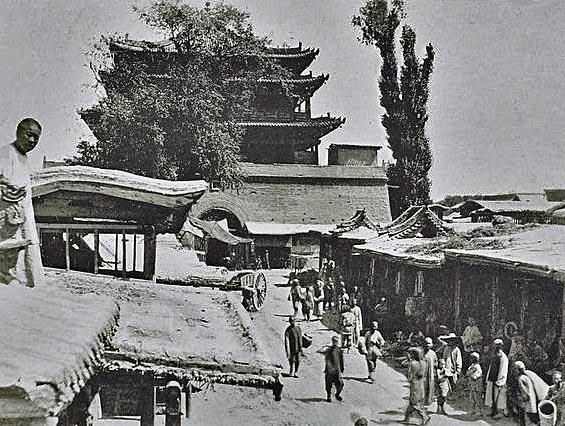
Kanchou
the Great Gate
Kanchou was from the first intended to be the easternmost goal of my journey, and when on September 3 I again set out from it westwards, it was with the distinct feeling that my return to India and Europe had begun. But the immediate purpose of the long journey then begun was to take me back to the Tarim Basin for my second winter campaign.
Several considerations, archaeological as well as practical, obliged
me in the main to follow the great trade route which leads by way of
Suchou and Anhsi across the Peishan desert to Hami and thence to
Turfan. The fact that this high road between China and Turkestan has
been repeatedly followed by recent European travellers does not
detract from its historical or geographical interest, since the
greater part of it leads along a line to which Chinese expansion
westwards has clung since ancient times. But many considerations
oblige me to shorten my narrative from this point on, and the fact
that my return journey from Kanchou to Karashahr in the north-eastern
corner of the Tarim Basin lay over relatively well known ground is a
special reason for succinctness.
Desert
Cathay:
Anhsi 2
Sep 12 -
Oct 8, 1907
On my arrival at An-hsi I had the great satisfaction of finding my precious deposit of antiques quite safe. It was a pleasure also to be greeted by my old surveying companion Rai Lal Singh, whom the Surveyor-General of India, in response to an appeal despatched nine months before from Lop-nor, had kindly deputed to relieve Rai Ram Singh. On October 3rd I was at last able to let Rai Ram Singh start on his return to India, which he reached safely three months later after rapid and almost continuous travel via Khotan, Sarikol, and Gilgit.
There arrived also Chiang - ssû - yeh, whom I had despatched on a secret mission to Wang Tao-shih, bringing with him in the stealth of night four camels heavily laden with more manuscripts from the 'treasure cave.' A written proposal for further 'selections' sent through a trusty messenger had met with a cautious response; but in order to avoid all suspicions I was obliged to remain away from the scene and to entrust the execution to my ever-zealous secretary. How he had managed to secure the timorous Taoist monk, and to induce him for a very reasonable recompense to hand out at night over two hundred additional bundles of Chinese texts, was quite a dramatic story.
I was glad to leave behind me by October 8th that dreary carrefour of
Asia, An-hsi, and to be quit for a time of wearisome report-writing
and accounts.
Desert
Cathay
Hami-Kumul
Oct
19- 24, 1907
Eleven long marches carried us and our big caravan northwestwards to Hami through the barren hills of the Pei-shan. It was a wilderness of gravel and crumbling rock which we crossed here, a true stony ' Gobi ' with a width of over two hundred miles. With none of the successive ranges through which the route leads rising much above 6000 feet, there is little to observe here for the traveller who is not a geologist.
By the morning of October 24th I could at last cornmence my short
tour in the district. Enquiries about old remains had elicited that
certain ruins to be found west of Hami had already been partially
explored by German archaeologists, Dr. A. von Lecoq and Professor A.
Grünwedel, working from the side of Turfan.
I was eager to reach
Ara-tam, the object of my trip, in good time on the next day. Nowhere
in Turkestan had I seen a wood of such size and fruit trees in such
delightful luxuriance. For nearly a mile the road turned and twisted
among thick clumps of apple, apricot, and peach trees, and stately
yellow-leaved walnuts.
Desert
Cathay
Turfan Depression
Pichan
Nov 2 - Dec 1 , 1907
Six rapid marches across a wearisome succession of low and absolutely barren spurs with almost equally dreary depressions intervening brought me by loth November to the fertile oasis of Pichan. During the short halt there necessitated by topographical work, I was able to settle a provisional programme for my visit to the ruined sites of Turfan and for our surveys around them.
A German expedition under Professor A. Grünwedel, Director of the
Royal Ethnographic Museum of Berlin, and a high authority on Buddhist
art, had in 1902 visited Turfan.
Its discoveries of art and
literary remains of all sorts proved so important that provision was
promptly made by the Prussian Ministry of Education, under the
special patronage of the German Emperor, for the systematic
continuation of the work by means of scientific expeditions, Dr. A.
von Lecoq, a distinguished Orientalist, and then again under
Professor Grünwedel. Their excavations which had been carried on
with the help of abundant State means almost uninterruptedly from
1904 until about half-a-year before my arrival, had, as I knew, been
attended with well-merited success.
It could not be my object, during the few weeks I could spare for
Turfan, to attempt supplementing these protracted labours by digging
at sites upon which the German savants had already been able to
bestow ample time, unbounded scholarly zeal, and a thorough local
experience. But I was anxious to familiarize myself as well as I
could with the constructive peculiarities of the ruins, the art
remains left in situ, and what else might help me to understand
better the significance of the Turfan finds, and to use their
evidence for the interpretation of my own.
Desert
Cathay
Toyuk –Kara-khocha (Gaochang) – Yarkhoto
(Jiahe)
Late Nov, 1907
|
|
|
|
Consequently, Stein devotes only cursory remarks on these well-known sites. He shows himself overwhelmed by the size of Karakoto and by any archeological excavation in Yarkhoto, which the Germans had not searched. But seeing the difficulties of irrigating the large fertile tracts of the depression (-150 m below sea level) spends three pages on the subject of
The Karez irrigation system of Turfan
Nov
12-14, 1907
Karez (Pers) are underground canals clearly visible on GE by the rows
of their cleaning holes (enlarge the GE map). They are the backbone
of the irrigation in the Turfan Depression.
Wikipedia
Stein is fascinated by this method:
I had already, on the march to
Pichan, greeted with special interest that characteristic feature of
Turfan cultivation, the `Karez' or underground irrigation channel. I
knew it to be mainly responsible for the present flourishing
condition of the oases in Turfan.
On right and left along our
route we could see the lines of these underground channels marked on
the bare clay surface by the little circular heaps of earth which the
diggers had thrown up mole-like at the mouth of each successive well.
Starting at ground level from the area to be irrigated, a low, narrow
channel is tunnelled from well to well up the natural slope of the
basin, but at a gradient less inclined than its surface, until a
sufficient supply of water is tapped. The wells were said to range
here to depths of over fifty feet ; but the diggers are so expert
that, working in parties of four or five men, they could complete an
average Karez within half-a-year at a cost rarely exceeding twenty
pounds.
The land which a single Karez could irrigate might be
purchased originally for about fifty pounds ; but so rich is the
return for this outlay, the cost of the annual cleaning of the Karez
notwithstanding, that such newly cultivated land would within a few
years sell for three times the money originally invested.
It was
generally acknowledged that the Karez construction was an innovation
dating back only a century or so, and introduced from Iran. In
agreement with this is the fact that none of the old Chinese accounts
of Turfan, which are numerous and often detailed, ever alludes to the
Karez system.
Desert
Cathay
Kara-Shahr - Ming-Oi
Dec 8 - 26, 1907
In spite of all the interest of its ruins I was glad by December 1, 1907 to set out again from Turfan; for now the increasing cold warned me that it was high time to regain the basin of the Tarim for the winter's work in the desert. I covered the 180 odd miles to Kara-shahr in eight rapid marches.
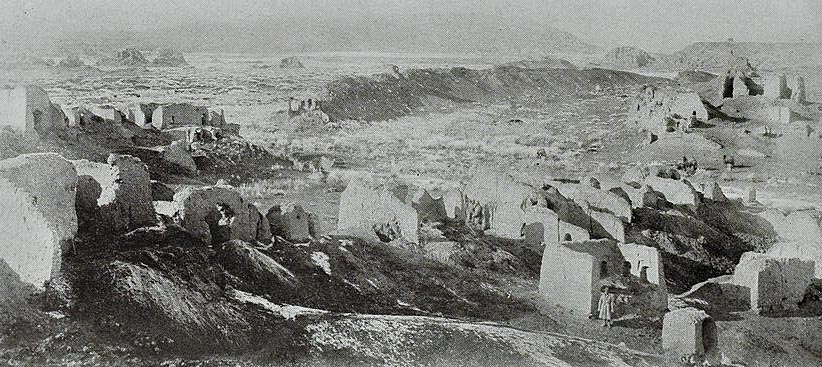
Ruins
of Karashar-Ming-Oi
Kara-shahr looked a small and poor town ; yet in recognition of its manifest strategic and administrative importance it boasted of a full-blown prefect. Being a subordinate of my old friend, Tao-t'ai P'an Ta-jên, he gave me the kindest welcome. His help proved particularly useful when, after a rapid examination, I decided upon systematic excavations at the extensive collection of Buddhist shrines situated near Shikchin, some fifteen miles to the south-west of Karashahr, and known to the Turki-speaking Muhammadans as Ming-oi,`the Thousand Houses.'
http://dsr.nii.ac.jp/toyobunko/VIII-5-B2-8/V-2/page/0559.html.en
The main site of the ruins dot a series of low rock terraces jutting out from the last spur of the hill range which flanks the valley of the Kara-shahr River on the south. A desolate waste of sand and scrub stretches around without a trace of ancient occupation. Fortunately a little spring of fairly drinkable water rises at the foot of one of the rocky ledges. So by the evening of December 11 I was able to pitch camp at once in the midst of the ruins.
It was easy to realize that the disposition of the ruins in long rows of detached cellas, varying in size but similar in plan and construction, and all in close proximity, would facilitate the employment of a large number of labourers, and thus help me in making the most of my time. Fortunately, too, there was the populous village tract of Korla only some twenty miles off to supply willing contingents of Turki Muhammadans who knew how to use their Ketmans. The efficient staff of village head-men which the prefect's care had provided made it easy to keep my bands at work from the bitterly cold hours of dawn until nightfall, and to have relays of men ready to relieve them as soon as the effect of long days of such strenuous work under conditions necessarily involving exposure began to tell upon them.
The photograph will give some idea of the general aspect and irregular distribution of the shrines. Their total number at the main site amounted to close upon a hundred. The dimensions varied greatly, from miniature cellas of four to six feet square to massive rectangular piles of brickwork measuring up to eighty-five feet on one side.
That all the exposed portions of the structures had suffered from the destructive effects of rain and snow was easy to observe at the first glance. But the excavations had not proceeded far before it became certain that most of the shrines had been subjected also to a great conflagration. Since none of the numerous finds of Chinese copper coins, originally deposited as votive gifts, were later than the close of the eighth century A.D., it seemed reasonable to connect this burning with the earliest Muhammadan invasions.
|
|
|
Stucco Heads, Showing Graeco-Buddhist Art Influence, From Ruined Shrines, 'Ming-Oi'
The deep débris layers filling the interior of the larger shrines yielded a great quantity of fine relievo sculpture in stucco, much of it fragmentary and small in size, yet of great artistic merit. In all cases of good preservation the stucco (retie, mud plaster) was quite hard, a result evidently due to the effective firing which these pieces had undergone when the shrines were burnt down.
During the fortnight spent at the Shikchin ruins we worked under
quite Sarmatian conditions. Minimum temperatures down to 42 degrees
Fahrenheit below freezing-point I should not have minded so much, had
we been saved those chilling vapours sent forth by the great Baghrash
Lake south. Day after day an icy mist enveloped ruins and camp. The
nightly hoar - frost practically amounted to a light snowfall, and
continued to cover the ground even when the sun fitfully struggled
through at last. For some days I almost despaired of getting adequate
light for the needful photographs, and the hoar- frost is conspicuous
in most of them. Fortunately there was shelter of some kind for the
men among the small cellas still retaining part of their
vaulting.
Desert
Cathay
Kuchar
Jan 18-26,
1908
From Korla I struck by forced marches through the broad belt of unsurveyed desert north-westwards, and after reaching the great northern caravan route at Bugur, made my way to Kuchar. At this great and ancient oasis I utilized a week's halt for visits to the interesting ruins close by, which had during the preceding five years been searched successively by Japanese, German, and Russian archaeological parties, and had finally been cleared with a thoroughness and method deserving of all praise by the French mission under Professor Pelliot.
Kuchar, situated at the foot of the T'ien-shan, and watered by two large rivers which debouch here, may by reason of its geographical position and historical importance claim to be a worthy pendant of Khotan in the south. So the rapid survey I was able to make of the ruins, and especially of the old Buddhist temples and grottoes which survive in a much-decayed condition at the mouth of the two river gorges, proved very instructive.
Apart from these archaeological visits there was much to keep me busy during my halt at Kuchar. It was there that I finally had to settle all plans and arrangements for the journey which was to take me through the desert to the southern edge of the Taklamakan.
Hedin, coming from the south, had left the end of the Keriya River with the certainty of striking the broad goal of the Tarim right across his route at some point or other, if only he kept long enough to an approximately northern course. For us coming from the north the case was essentially different. Our hope of reaching water within reasonable time depended solely on our ability to steer correctly across some 150 miles of high dunes towards a particular point—the termination of the Keriya River which flowed, not right across our route, but practically in the same direction; it involved also the assumption that the river still actually sent its water to where Hedin had seen it.
Through the Taklamakan Desert
along the Keriya River
Jan 27 – Feb 25, 1908
Even today this longest north-south traverse through the Taklamakan between Kuchar and Khotan is still the domain of Chinese adventure tours – by four-wheel-drive – there is no highway. In Stein's day it was a dangerously desolate terrain of high, waterless dunes. Sven Hedin, after nearly losing his life, had pioneered the route in the opposite direction in January 1897. Using Hedin's maps it became the ultimate test of Stein's and his Indian surveyor's superior navigational skills.
The Tarim River
Jan 29, 1908
Our hope of reaching water within reasonable time depended solely on our ability to steer correctly across some 150 miles of high dunes towards a particular point—the termination of the Keriya River which flowed, not right across our route, but practically in the same direction ; it involved also the assumption that the river still actually sent its water to where Hedin had seen it. Nor could I overlook the fact that, however justified my reliance in Hedin's careful mapping was, differences in longitude deduced from mere route traverses were bound to be considerable on such ground, and in our case all depended on the assumed longitude being right.
There would be great risk of our water-supply getting completely exhausted, and of animals—if not of men, too—succumbing through thirst long before the line of wells and oases at the foot of the Kun-lun could be reached.
Against these objections there were to be reckoned the loss of time and other drawbacks which any change of plans would involve. After careful consideration I decided to stick to my programme and to guard, within the limits of human prevision, against the risks lying before us.
The fifteen camels we took with us were by no means too many, considering that six weeks' food supplies had to be carried for a party counting altogether twenty men, and that at least eight animals would be needed for the carriage of ice to provide a reserve of drinking water. Once in the desert everybody had to walk, though I had rather rashly agreed to take four ponies along in order to assure greater mobility for my Indian assistants and myself after we should have reached the Keriya River.
For nearly thirteen miles we passed through patches of cultivation alternating with scrubby steppe of equally fertile soil, but left untilled owing to want of water. As we approached the riverine belt of the Tarim, fenced sheep-runs, which I had seen nowhere else in Turkestan, became frequent. Then behind a narrow line of dunes we struck the big bed of the Tarim. The river, hard frozen, now filled two channels 300 and 120 yards across ; but the total width of the bed was nearly three miles, attesting the enormous volume of the summer floods.
From there we marched on January 29th under old Khalil's guidance south-westwards, and after moving all day through a belt of luxuriant Toghrak jungle and reed-beds.
Searching for the Keriya River
Feb 2 - 13,
1908
Tokhta, Khalil's thick-headed son, who was at this point acting as our guide, turned off to the south-west, and by nightfall brought us to the promised pools in a network of deep-cut dry river beds. The pools, fully twenty-five feet or so below the level of the surrounding ground, did not look very inviting, with shores of black hard-trodden mud and a tangled mass of decayed reeds. But the water in a rough well constructed by their side proved quite fresh, and the supply of ice was abundant. The cutting of ice went on all through the night and early morning, and it was not till 10 A.M. that we could set out with eight huge bags duly filled and loaded on as many camels. All the camels received here their last watering, six to eight bucketfuls making up the regulation `drink' before a long journey through waterless ground.
Tokhta's rôle as guide had come to an end; for we now shaped our course by the compass due south until we should strike the Keriya River delta.
After a short march of only a little over ten miles we were obliged to pitch camp in the midst of towering dunes. Luckily here, too, depressions showing damp soil were frequent, and the well we dug in one of them yielded water at five and a half feet, somewhat less brackish than at the previous camp, but too scanty to save much of our ice.
Next day, February 2nd, we had a desolate march under a grey sky heavy with clouds, amidst high bare dunes rolling on all sides like the waves of a ' choppy' sea. The first five miles lay over a regular Dawan of closely packed ridges rising to fifty and eighty feet above the rare depressions. It was well that I could encourage my men by pointing to signs of moisture in the latter.
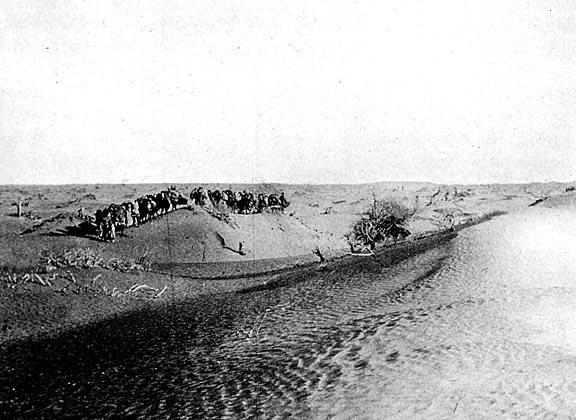
Marching
for the Keriya River Sink
Next day after three miles' weary tramp along the crests of huge dunes, we emerged upon a broad belt of living poplars and tamarisks. It was a strange sight, this strip of vegetation stretching away to the north-north-east for at least six miles, and for two more to south-south-west
They helped to keep up the spirits of our hapless Shahyar men, who no longer believed that they were being led to their doom, but fondly fancied the Keriya River to be quite near. The well I had dug led through hard-frozen damp sand to water at a depth of only three and a half feet, and the water was now perfectly sweet. So there was contentment throughout the camp.
Our march on February 4th seemed easy; for the dunes soon sank to a modest height, eight to ten feet, and only two Dawans were encountered on the fourteen miles' march to the south. But as we marched on, the number of dead trees and bushes increased, while living Toghraks were now rarely within view.

Camping
in a waterless place, Feb 4, 1908
The ground, where clear of dunes, had changed to hard clay, and I was not surprised when at the place where the dusk obliged us to halt, our attempt to reach water by digging fifteen feet deep proved fruitless.
It was sad to watch the depressed look in the men's faces as they came up two hours later and found that my advance guard's halt meant no water. A mile and a half more was covered that evening, and then we had to halt for the night amidst dismal dunes rising to thirty feet and more. The last night's temperature had dropped to twenty-eight degrees of frost. So we were glad to have at least plentiful fuel in the débris of ancient poplars, fallen who could say how many centuries ago. Our water-supply had now been reduced to three large bags and two galvanized iron tanks full of ice. Still, with all care for economy, I thought it right to let each of the ponies have a pint of water.
It was a poor night's rest for me, for the anxiety to ake the men in good time for an early start kept me from sleep after 2 A.M. The packing and loading was done in darkness. After going for a couple of miles over heavy dunes we were just approaching a broad Dawan some sixty feet high when the frequency of living tamarisks attracted my attention.
More with a wish to divert the gloomy thoughts of the Shahyar men than from any real hope I set them to work here. After clearing away some two feet of drift sand, blue clay was struck which felt heavy, with the faintest suggestion of damp.
At last the strokes of Muhammad, the best of the Shahyar men, who was digging away at the bottom, gave a clicking sound suggestive of increased moisture, and at ten feet depth the damp sand changed into mud. Two feet more, and water began slowly to gather under the man's feet. It was deliciously fresh, but gathered quite slowly.
The track which Lal Singh had followed under my instructions to S. 190° W., kept steadily rising over broad rolling dunes, and after about ten miles ascended the shoulder of a mighty ridge of sand culminating at a height of about three hundred feet. I caught up the camels just as they were rounding the ridge only a hundred feet or so below the bold line of its summit, and almost at the same time saw to my delight a broad valley-like belt of dead forest and living tamarisks stretching away below to south-south-west. The high sands we had just crossed and this continuous stretch of dead jungle agreed well with the description Hedin had recorded of the ground where on his march from the south he had finally lost touch with the dry river bed marking the former extension of the river. I felt, indeed, almost assured of having hit the very point which his map shows as Camp xxiv.
It seemed like a triumphant vindication of the accuracy of Hedin's mapping and of our own steering; yet as I look back to it now, it was too accurate to be true....
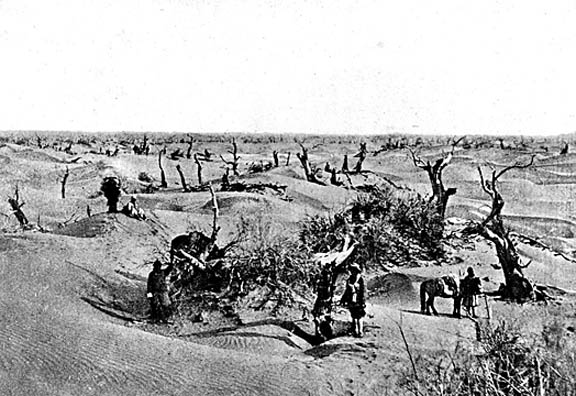
The
northern end of the old Keriya River Sink, Feb 7, 1908
When we had descended from the Dawan there was, indeed, good cause for rejoicing. Amidst low dunes and tamarisk cones we came upon a regular grove of fine old Toghraks, some living, some dead. Here camp was pitched ; and before dusk had settled, Hassan Akhun, whom I had told off to search what unmistakably was an old river bed marked by eroded clay banks, came back with hysterical shouts of elation. At a point some eleven feet below the level of the nearest bank, the surface of the sand was in truth hard frozen, and when this had been hewn through with some trouble it needed only digging to a depth of scarcely more than four feet to give us water. I t tasted delightfully fresh, but once again it gathered but slowly.
However, we had a whole night to fill kettles and buckets. Contentment was great that evening throughout the camp. It seemed as if our main troubles were now ended. I had a huge dead tree turned into a bonfire to guide Ibrahim Beg, and warmed myself by its blaze until I could retire to my little tent. The night promised to be cold, under a sky at last perfectly clear of clouds, and, in fact, I registered next morning a minimum of thirty-seven degrees of frost. My chief treat that cheerful evening was a `wash,' such as I had been sadly obliged to forgo for days. From the men's camp fire came sounds of a `Rabab', a string instrument they had brought along from Shahyar to console themselves with in the wilderness. Under the stress of the last week's marches its merry strings had remained silent.
Next day after a couple of miles we decided to resume our southward course as the safest. Over high ridges of sand we regained the bed followed during the morning. But shortly afterwards all traces of it disappeared under heavy dunes.
Vainly I climbed up the sand cones and ridges to catch a glimpse of the river bed which we had been following. Yet suddenly, when the sun was setting and I had almost abandoned all hope of securing a few living Toghraks for our poor camels to feed upon, the screen of dead tamarisk cones opened, and we emerged once more on a short reach of old river bed. There was no hope of reaching water here. Yet the men, driven by thirst, settled down in sullen despair to digging a well. After eight feet or so no trace of moisture appeared, and the work was stopped.
The Open Keriya River at Last
But the river proved elusive. They would tramp on for another 6 days through high dunes occasionally encountering clumps of dead trees and dug water holes. They came across foot prints of two hunters, but they got lost again, moreover in the wrong direction. At one point the men attempted a small mutiny, which Stein after some quarreling with a despondent Tokhta, was able to divert.
Feb 13, 1908
A high ridge of sand which had guided us so far now rose 300 ft quite close on our right, and was too good a survey station to be missed.
From the top the panorama was grand, but also desperate at first sight. I was searching the ground with my prismatic glasses for indications of living jungle, when suddenly to the south-south-east some narrow bands of white caught my eye. Looking more closely through the binocular I could scarcely believe my eyes when they showed me in four distinct places glittering streaks of what could only be ice—or else salt efflorescence. The distance was fully four miles. I did my best to prepare myself and the rest for disappointment.
The whole caravan was now moving ahead at a pace such as it had never attained since we entered the desert. A mile farther ahead a halt had to be made to unload the theodolite needed by Lal Singh for his mid-day observation. We had scarcely moved ahead more than a few hundred yards when a figure was seen running frantically towards us. It was young Turdi, my second camel-man, who had previously broken ahead in his eagerness to make sure of the water. What he waved in his hands was soon recognized as a big cake of ice.
It was ice, a big sheet of ice, Turdi reported as soon as he had recovered breath for articulate speech, and flowing through it a current of fresh water! It was the real river, then, we had struck, changed to a new bed in this desolate desert. Half a mile farther ahead we should reach it.

The dunes in front of us were so high that we did not realize the full width of the river until we almost dropped down over the last steep sand slope on to its ice. In a glittering sheet of clear ice it stretched away to the north. But where the current had cut into our bank the water, a couple of feet deep, flowed in an open channel about twelve feet broad at the rate of about half a yard per second. The men rushed down to the brink, and bending down on hands and knees took time over their drinks as probably never before.
Karadong -Domoko
Feb
19 – Mar 15, 1908
The ground we had passed through had its own fascination, and survey work on it offered considerable geographical interest. Yet I was glad when, after a day's much-needed rest, I could by February 19th, 1908, resume archaeological labour at the Kara-dong site, which the river by its latest change has again approached after long centuries.
On Feb. 21 I decided to move up the river in order to meet as early as possible the party of my old `treasure-seeking' guides from Khotan whom, by an arrangement via Kashgar, I had ordered up before starting from Kuchar. By February 25th I had the satisfaction of seeing a dozen familiar Khotan 'Taklamakanchis,' under the direction of Roze, old Turdi's quondam acolyte, join me near my old camping-ground at Kochkar-öghil.
After a hearty welcome from my old friends, I marched with my band of `treasure-seekers' by a new route to the desert belt north of the oasis of Domoko.
The excavations which I was able to effect rapidly during the first half of March, with a relatively large number of labourers easily recruited from Domoko, were rewarded by valuable finds of well-preserved manuscripts in Sanskrit, painted panels, and tablets inscribed in the language of old Khotan.
Some of our best finds at this site were made within a small Buddhist shrine which occupied a quite unusual position, emerging from the side of a tamarisk-covered sand-cone about forty feet high.
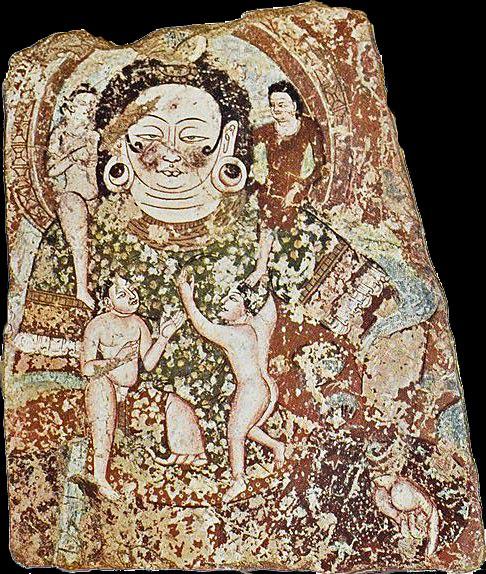
Hariti
with her Children
Among the frescoes covering the walls inside was the fine panel of
Hariti, the Indian goddess of smallpox. In full accord with the
euphemistic conception exemplified by a number of Graeco-Buddhist
statues from Gandhara, the dread goddess, the destroyer of children,
is represented as a kindly, richly dressed matron with young boys
playing around her arms and shoulders. [Hariti is a Near-Eastern
figure who came with the Greeks to Gandhara, merged with Kali and
converted to Buddhism became a popular protectress of children and
their mothers. This is the eastern-most appearance of hers.]
Desert
Cathay
Khotan 2
Mar16-April
5, 1908
The remainder of March was spent in supplementary archaeological labours at a number of old sites around Khotan, like Karayantak, Ulugh- Mazar, and others along the desert fringe. My short halt at Khotan during the first days of April was made most pleasant by the welcome my old friends gave me, and by the satisfaction I felt at seeing all my antiques sent from Kuchar now safely stored in Akhun Beg's house.
So by April 5th I said goodbye again to old friends and familiar
surroundings at Khotan, and started on the journey which in the end
was to take me to Ak-su and the foot of the T'ien-shan.
Desert
Cathay:
Mazar-tagh
April
16-10, 1908
After the brief stop at Khotan Stein decided to make a second traverse of the desert going north along the Khotan river by the well-trotten caravan route to Aksu.
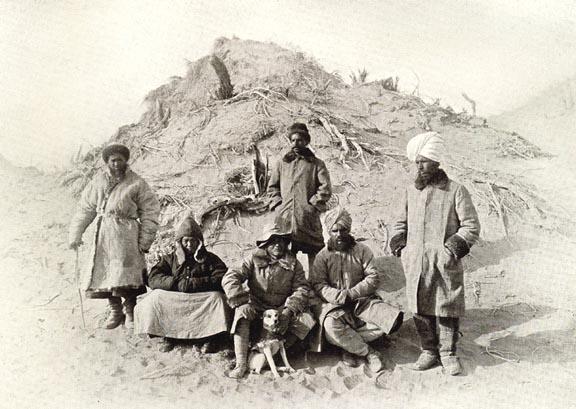
Stein
with his dog Dash
I had
already heard vague reports about the existence of old remains on the
curious desert hill of Mazar-tagh, which, as the last offshoot of a
low and almost completely eroded range from the north-west, juts out
to the left bank of the Khotan River.
On April 16th I
reached the hill, which rises with its gaunt and barren cliffs of
reddish sandstone some two hundred feet above the wide river bed and
the sandy wastes by its side. My satisfaction was great when I found
its top occupied by the ruins of a small and relatively well
preserved fort. This had clearly been built to guard the route
leading by the river.
The little fort, looking down from its precipitous height like a true robbers' stronghold, had been burnt out long ago; yet its siege, or rather that of its rubbish heaps, kept us busy for three long and hot days. Tibetan records on wood and paper cropped up with miscellaneous relics when we cleared out the few still traceable halls and quarters inside. But their yield was trifling compared with that of the masses of refuse thrown down by the occupants in the course of long years on to the steep rock slopes below the east face
It
seemed like another Miran, with all the unspeakable dirt which these
old Tibetans seem to have accumulated wherever they held posts, and
with all its peculiar concomitant odours still fresh in my
recollection. Buried in the thick refuse layers lay Tibetan tablets
and papers by the hundreds, along with documents in Chinese and
Brahmi script, and rarer pieces in Uigur and some unknown writing.
The Tibetan records greatly predominated, pointing, as in the case of
Miran, to the period of Tibetan invasions during the eighth and ninth
centuries A.D.
Desert
Cathay
Aksu
April 27 -
May 6, 1908
On April 10th I started from Mazar-tagh down the dry bed of the Khotan River for Aksu. During the eight rapid marches which carried us north to the river's junction with the Tarim we suffered a good deal from the increasing heat of the desert and a succession of sand-storms. Such conditions made me realize with full intensity the experiences of Hedin on his first disastrous crossing of the Taklamakan in May of 1896. Kasim, who had met him afterwards during his enforced rest at the shepherd camp of Böksam, was able to show me the pool of fresh water, some twenty miles lower down on the right bank, which had proved the great traveller's saving.
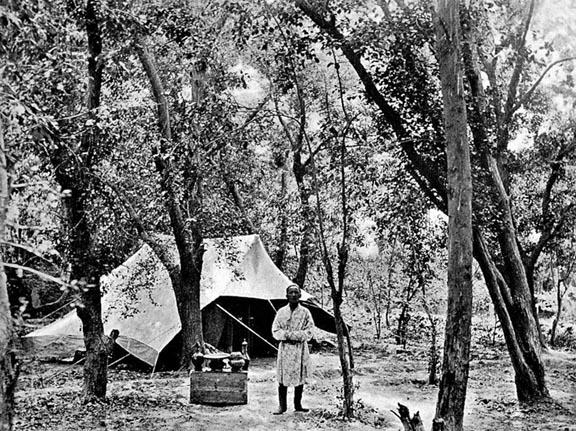
My
tent in the Beg's garden at Aksu
At the district headquarters of Ak-su I found an excellent camping-place in the shady garden attached to a Beg's suburban mansion, and next day had the great joy of greeting again my old Mandarin friend, P'an Ta-jên, the Tao-t'ai
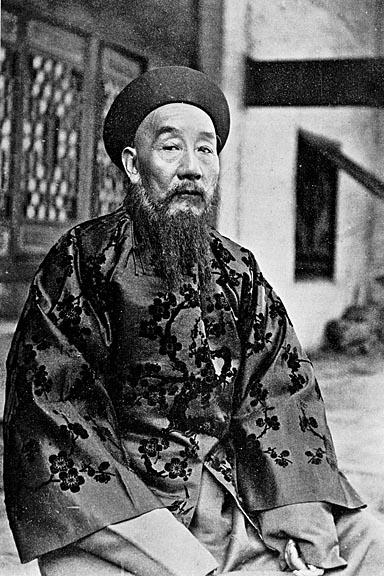
P'an
Ta-jên, the Tao-t'ai
It was a
satisfaction to me to thank my dear old friend in person for all the
help he had extended to me from afar, and my stay, which I prolonged
for his sake to five days, passed most pleasantly. During our daily
forgatherings there was so much to tell him about the results of my
two years' explorations, and so many cheerful reminiscences of old
Khotan days to revive. I had brought a few specimens of my finds from
the Tun-huang Limes and elsewhere for P'an Ta-jên's benefit, and to
see him reverently handle and study those Han relics was a
treat.
Honest Chiang-ssû-yeh, too, well deserved a special effort
on my part. P'an Ta jên's friendship was to be utilized in order to
obtain for Chiang the chance of official employment he had vainly
striven for ever since he first came to the New Dominion some
twenty-five years before. So a detailed report on his former services
and all he had done for me was drawn up for submission to the Fu-t'ai
or Governor-General at Urumchi, nominally in my name and ending with
a recommendation for the grant of official rank.
After a brief detour into the foothills of the Tienshan in search of some elusive ruined town Stein turned south towards Yarkand. Should he visit Kashgar? He knew, the Macartneys were in England on furlough, it was hot and the end of May, he felt pressed by time, and his camels had to be sold. He decided to push for Yarkand.
Yarkand
June,
1908

My
Faithful Camels for Sale
At Yarkand I was obliged to halt for a few days, mainly in order to dispose of my brave camels from Keriya. I t seemed hard to part with these sturdy companions which had served me so well during nearly two years' desert travel. But they could not be used for the journey across the mountains to India, and Yarkand, where the currents of trade from the north and south meet, seemed the right place to get a good price for them.
The heavy season of traffic to the Indian and Russian sides was approaching, and when the owners of camel caravans had convinced themselves that I was in no hurry to sell, the offers, ridiculously low at first, began to rise steadily. At last they topped my own estimate, and then with a secret pang I had to let my faithful beasts pass into the possession of an Afghan trader. The price he paid down in hard rolls of silver amounted to 51 Taels, or roughly 130 rupees per animal, and yielded a net profit of 70 per cent on the original cost—for the benefit of the Indian Government.
For the last few days my camels had been feasting on bundles of
fragrant dry lucerne and on young foliage around ` my' garden palace
of Chini-bagh. Now for a farewell treat they had a huge loaf of bread
from my own hands, and took it almost as eagerly as when I fed them
in the heart of the desert. Have they ever since wished to be back
with their master—as I have often wished to travel again with them
?
Desert
Cathay
Khotan 3
July-
Aug 4, 1908

Packing
the Treasures in Khotan
There followed six weeks of constant toil for me, absorbed entirely by the sorting and packing of my archaeological collections.
Never, perhaps, has the oasis seen such making of cases and tinning,
as went on in the courtyard of my old palace during those long hot
weeks. There were, indeed, some leisurely `Ustads' to direct in a
more or less casual fashion the labours of the dozens of men who were
sawing up seasoned tree trunks and planing boards for cases. But the
actual repacking of the antiques in the tinned cases had to be done
entirely by my own hands. The strengthening of the frescoes from
Miran and elsewhere by a backing with glued strips of cotton and then
the tight repacking between layers of reeds, as already described,
cost weeks.
The results of my minute care and manual pains then
taken have been gratifying indeed ; for those ancient relics, even
when composed of the most brittle and friable materials, have safely
survived all the risks to which they were exposed on a total journey
of some 8000 miles, while being carried across high mountain ranges
on camels, yaks, and ponies, and subsequently travelling by cart,
rail, and steamer. But it was a wearisome time while I toiled thus
during the hottest season day after day without any interruption from
daybreak ; only at dusk seeking a little refreshment in walks or
rides along the dusty roads through the village tracts northward.
On August 1st I was at last able to despatch my heavy convoy of antiques, making up over fifty camel-loads, to Sanju. There, under the care of Tila Bai and one of Badruddin Khan's trusted caravan men, it was to wait until the subsiding of the summer flood in the river would allow it to proceed in safety to Suget on the upper Karakash, where I hoped to rejoin it towards the close of September for the crossing of the Karakoram.
On August 4 I rode on, the quivering glare and heat of the desert seemed to descend like a luminous curtain and to hide from me the most cherished aspects of my Turkestan life.
Search for the Sources of the Yurung-Kash River
Stein's Last Kunlun
Exploration
Aug 4 – Sep 30, 1908
As usual with Stein's topographic surveys I spend several days reading some 40 pages in an attempt to reconstruct his route through unidentifiable gorges, passes, and localities. The alingment of the route I present on my GE map is at best approximate but not much worse than the one on Stein's map. Still this time his travel was across such unimaginably difficult terrain and ended in disaster that a few photos and dates are useful in understanding what happened. Ironically the few Panoramio photos of the area in GE helped greatly in definig some of the rivers and valleys he mentions.
Traverse to the Tibetan Plateau through the Polur Gorges
Five long marches brought me on August 8, 1908 from the edge of the Khotan oasis to the mountain village of Polur, where the westernmost route from Tibet debouches. We were now steadily ascending in a diagonal line the great gravel glacis which slopes down from the northern main range of the Kun-lun, and I felt with delight how each night's halt gave increased coolness.

One
of the bridges across the Polur Gorge, Aug 14. 1908
On August 12th the whole of Polur was assembled to see us off; for though this route to Western Tibet had been used about half-a-dozen times by European travellers since the 'Pandits' of the Forsyth Mission first traversed it in 1873, the novelty of such an event had not worn off.
The difficulties began early as we made our way through the confined
gorges above Polur towards the high plateaus beyond the northern main
Kun-lun Range. There were continuous crossings and recrossings of the
greyish-white tossing water on breathtaking "bridges".
Desert
Cathay
The Sources of the Yurung-kash
River
On August 25th we set out with a minimum of
baggage on ponies and 9 Kirghiz porters by a very steep side valley
to the south, and crossed the rugged spur between the Polur-Zailik
and the main Yurung-kash Valleys by a pass over 17,700 feet (5400 m)
high, leading over what manifestly had once been old névé beds.
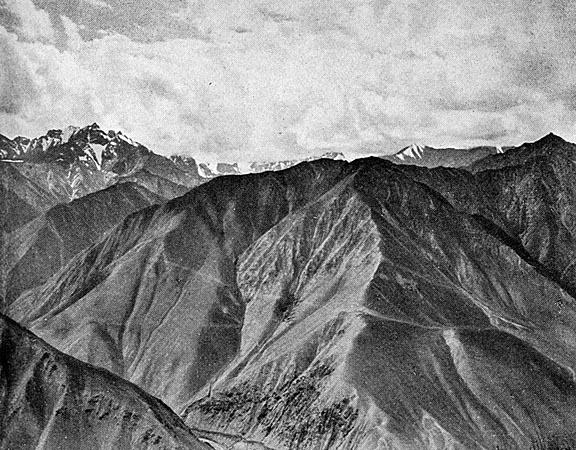
Path
along the Yurukash River, Aug 25, 1908
[The Yurungkash (Yurungkax) river has its sources at the southern edge of the Tibetan Plateau. After a short distance flowing north it makes a 90-degree turn to continue east for 60 km before it breaks through the Kunlun Range in an impassible canyon to the north to water the Khotan Oasis and vanish in the desert. Stein's aim was to suvey its sources and those of the Keriya River further southwest on the plateau.]
The view presented by the Yurung-kash Valley, where we reached it at an elevation of a little over 13,000 feet, was singularly impressive in its desolation. On both banks of the river, which here rolled its greyish-white glacier water in a bed some hundred yards wide, there was nothing to be seen but absolutely bare cliffs of red or yellow sandstone and detritus slopes below them. For over two miles our faint track wound along these dead slopes of rubble.
On September 3rd we set out for Ulugh-köl, and after marching over flat detritus plateaus bearing abundant traces of former glaciation, crossed the stripling Yurungkash just where its bed turns sharply south. Then an easy ascent over rubble beds past the snout of the much-torn Gügrüge glacier took us up to a grass-covered saddle, less than 16,000 feet above the sea, where the Yurung-kash drainage was left behind almost before we became aware of it. This would be the western most point on the jorney (see Stein's map).
My object was to follow the great snowy range, which flanks the
Yurung-kash head-waters on the south-east and south along its
southern slopes westwards, until we reached the uppermost valley of
the Kara-kash River, and thus to complete our survey of what had now
proved to be the true main chain of the Kun-lun.
Desert
Cathay
Searching for Yangi Dawan Pass
Sep 22, 1908
The Kirghiz had stopped close to the brink of a snowy precipice falling away many hundreds of feet to the névé beds of a big valley north. Having reason to apprehend snow cornices, I moved up to a slightly higher knoll of snow which stood farther back from the edge. The panorama before me was overwhelmingly grand. Straight to the north stretched a glacier - filled valley hemmed in by bold snow-covered spurs.
It was half-past four before this trying task was concluded, in a
temperature of 16 degrees Fahrenheit below freezing-point with the
sun still shining. I scarcely had time to eat a few mouthfuls of food
before the Kirghiz insisted upon starting downwards. No doubt, they
had good reason to fear our getting benighted on the glacier. But
their precipitate departure deprived me of the chance for a change in
my foot-gear which I had wished to effect. My mountain boots in the
course of the ascent had got wet through and through, and during the
long stay on the col with a rapidly sinking temperature they must
have become frozen.
Desert
Cathay
From the Kunlun to London
Sep 23 – Dec 1908
On September 23, I found myself suffering from
severe pains in my feet, and quite unable to move. The serious
results of my accident and the urgency of surgical help were only too
evident. I could not disguise from myself the symptoms which made it
probable that the frost-bite had affected not merely the flesh but
the bones, too, in some of the toes, at least on the right foot. My
mountaineering manual, in which the subject was discussed at some
length, plainly indicated that in such cases gangrene would set in,
and recommended that "the aid of an experienced surgeon should
be sought at once."
The advice was excellent but scarcely reassuring. For how could I secure such aid in these inhospitable mountains — and meanwhile might not gangrene spread further? So all my thought and energy had now to be concentrated on a rapid journey to Ladak. For only one day could I halt in that bleak camp under the frowning rock-walls to gather a little strength. I used it for sending Lal Singh to reconnoitre the gorge eastwards where we now located the approach to the Yangi Dawan. But he found it after a very short distance completely choked by snow and ice, and had to return. Evidently the advance of a glacier had here obliterated all trace of the old route.
The pains in my feet had increased, and next day when the start was made back to our main camp, I found that riding on a yak, owing to the low position of the feet, caused cruel suffering.
All I could do was to get myself strapped on the padded saddle of a camel, as soon as the going in the gorge became sufficiently safe for the animal under such a load. The constant jerks and swayings were most painful, and I shall not easily forget the sufferings of that day.
On September 30 I myself set out from the Kara-kash Valley with the lightest possible baggage on ponies and only my few personal servants, in order to reach Leh as rapidly as the conditions of the difficult Kara-koram route, leading over passes of more than18,000 feet and the troublesome Sasser glacier, would permit.
Half-way down to Portash, where I had previously ordered Tila Bai to join me with the heavy baggage, I was met by Muhammadju returning with heavy mail-bags brought across the Kara-koram from Ladak. The many letters from friends, now eagerly expecting me back in India and Europe, were cheering in spite of my crippled condition.
Portash was reached by September 27, and there I had the satisfaction
to see again my heavy caravan of antiques safely arrived across the
Sanju Pass. Not a single case had suffered, in spite of the
difficulties of the track and the exceptionally late flood in the
gorges. For two days I was kept hard at work on my camp-bed settling
the accounts of Satip-aldi Beg and of our Khotan 'Kirakash.
Desert
Cathay
Karakoram Pass
Oct 3, 1908
By two forced marches I got myself carried to Sarigh-ot-darwaza, a point on the terribly bleak uplands where we struck the Kara-koram trade route (Sep 31). Then we followed the latter with its unending line of skeletons, sad witnesses of the constant succession of victims which the inclement physical conditions claim among the transport animals, and by October 3, 1908 we crossed the Kara-koram Pass, 18,687 feet (61321 m) above sea, and with it the frontier between China and India.
It was hence a great relief when, at the foot of the very first
impasse, my sorry little caravan was met by a band of Tibetan coolies
with which Lala Udho Das, the energetic and attentive Naib Tahsildar
of Leh, had pushed across the Sasser Pass. Without this timely help
which Captain D. G. Oliver, of the Indian Political Department and
British Joint Commissioner in Ladak, had provided, I could never have
got myself carried in my litter over the ground before us—and I do
not care to think now what sitting in a saddle would then have meant
for me.
Desert
Cathay
Sasser Pass
Oct 7, 1908
On October 7th I was taken over the glacier slopes and moraines of
the Sasser Pass, the patient and good-natured Ladaki coolies doing
their best to spare me painful tumbles on the ice and snow. But it
was sad to think how a few weeks earlier I should have enjoyed such
grand mountain scenery and such a glacier climb. Now the best I could
do was to divert my thoughts, by reading, from the little miseries of
the present and from worrying anxiety about what would become of my
feet.
Dersert
Cathay
Leh
Oct 12 - Nov
1, 1908
At last by the evening of October 8, when descending towards Panimikh, the highest Ladak village on the Nubra River, I had the great relief of being met by the Rev. S. Schmitt, in charge of the hospital of the Moravian Mission (Herrenhuter Mission) at Leh. Though himself then still suffering from the aftereffects of a serious illness, he had with kindest self-sacrifice hurried up by forced marches across the high Khardong Pass in order to bring me help. I reached Leh on October I2, having travelled nearly three hundred miles since my work closed at the foot of the Yangi Dawan.
Two days later Mr. Schmitt successfully effected the operation on my right foot, all the toes of which had to be amputated either completely or in their upper joints. The wounds left after the amputation were very painful and healed with extreme slowness. The risk of finding the Zoji-la Pass on the route to Kashmir closed by snow urged an early departure from Leh if I were to reach India before next spring.
At last, by November 1, I was able to say good-bye to Mr. Schmitt and
the other members of that excellent Mission Station
Desert
Cathay
Srinagar and the Return to
London
Nov 13, 1908 – Mid Jan 1909
At last, by November 13, I reached Srinagar, where another long halt was imposed by the medical advice of my old mountaineering friend, Dr. Arthur Neve. He was able to confirm the assurance that my powers of walking and climbing would prove practically unimpaired, in spite of the loss of my toes, as soon as the wounds left by the partial amputation of them had healed.
Towards the close of November, I could begin my first attempts at walking with crutches, and by December 1 start down on my way to India. My wounds had not yet completely healed. So the rest and care I could enjoy at Lahore under the hospitable roof of my old Punjab friend, Mr. E. D. Maclagan, was a great boon.
On the day after Christmas, 1908, I was at last able to embark at Bombay for Europe. That very morning I had been obliged to part from `Dash,' the last of my faithful travel companions, but, perhaps, the nearest to my heart, since the P. and O. Mail boat would not receive him amongst its passengers.
By the time I reached London, after the middle of January, I was able to walk without pain and to feel quite sure of the day when I might climb again on the mountains. But it was to me an equally great satisfaction that all my cases with antiques, close on a hundred in number, had just then safely arrived there.
So with all these tasks and responsibilities before me, I had reason
to feel grateful when the Government of India's generous proposal to
allow me a period of two years and three months' `deputation' in
England for this purpose received the Secretary of State's sanction.
Thanks to this consideration, my labours could proceed steadily both
at the British Museum and at Oxford, where the kind hospitality of
the Warden and Fellows of Merton College offered to me as peaceful a
retreat for work as I could wish for in this ancient home of
learning. I was thus assured of the chance of accomplishing what the
results of this journey had imposed upon me as a duty to science. But
when may I hope that the gate will open for work in those fields to
which cherished plans have been calling me ever since my youth, and
which still remain unexplored ?
Desert
Cathay: